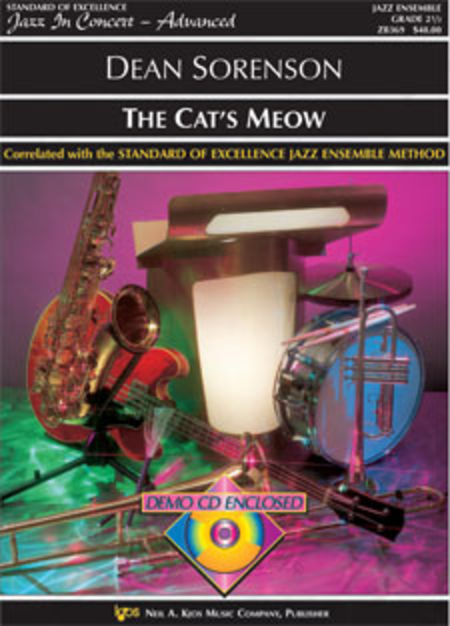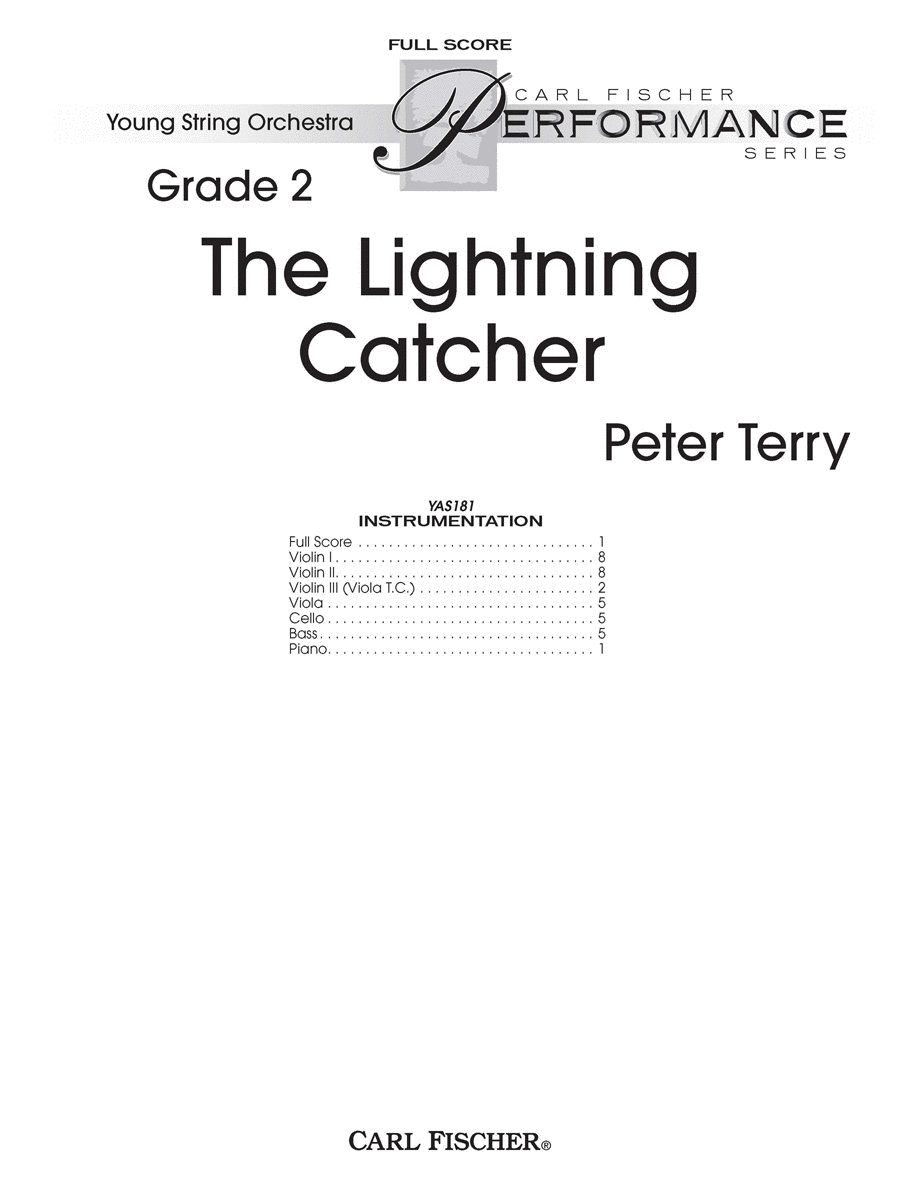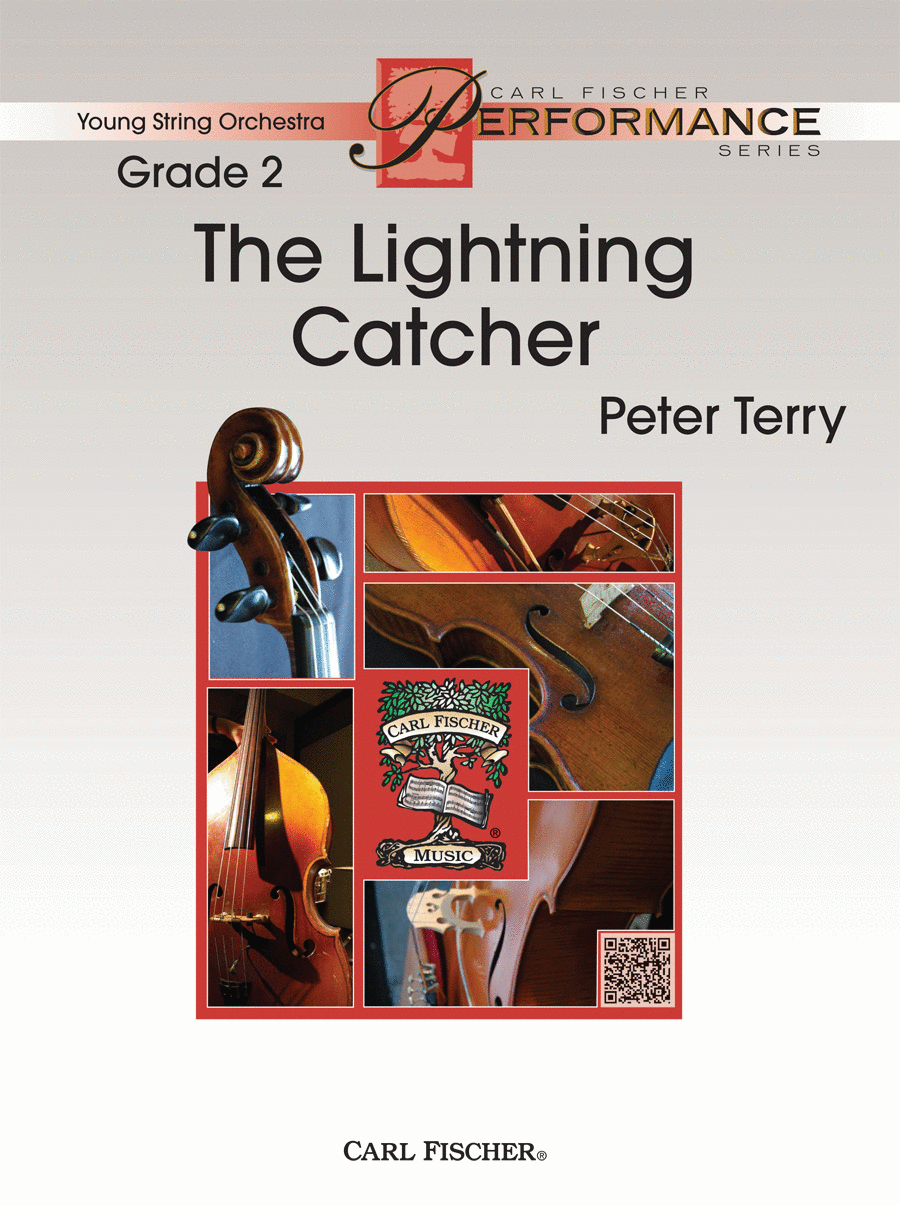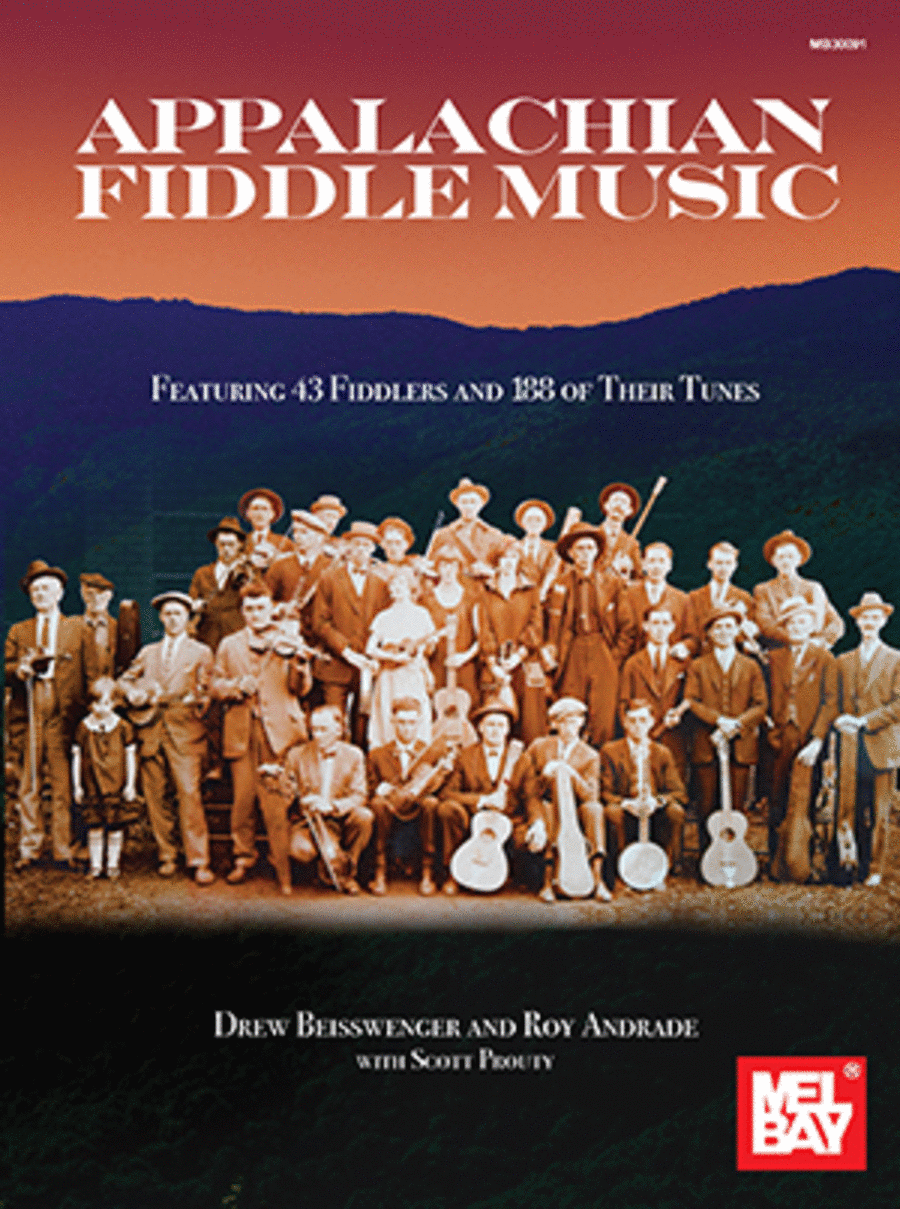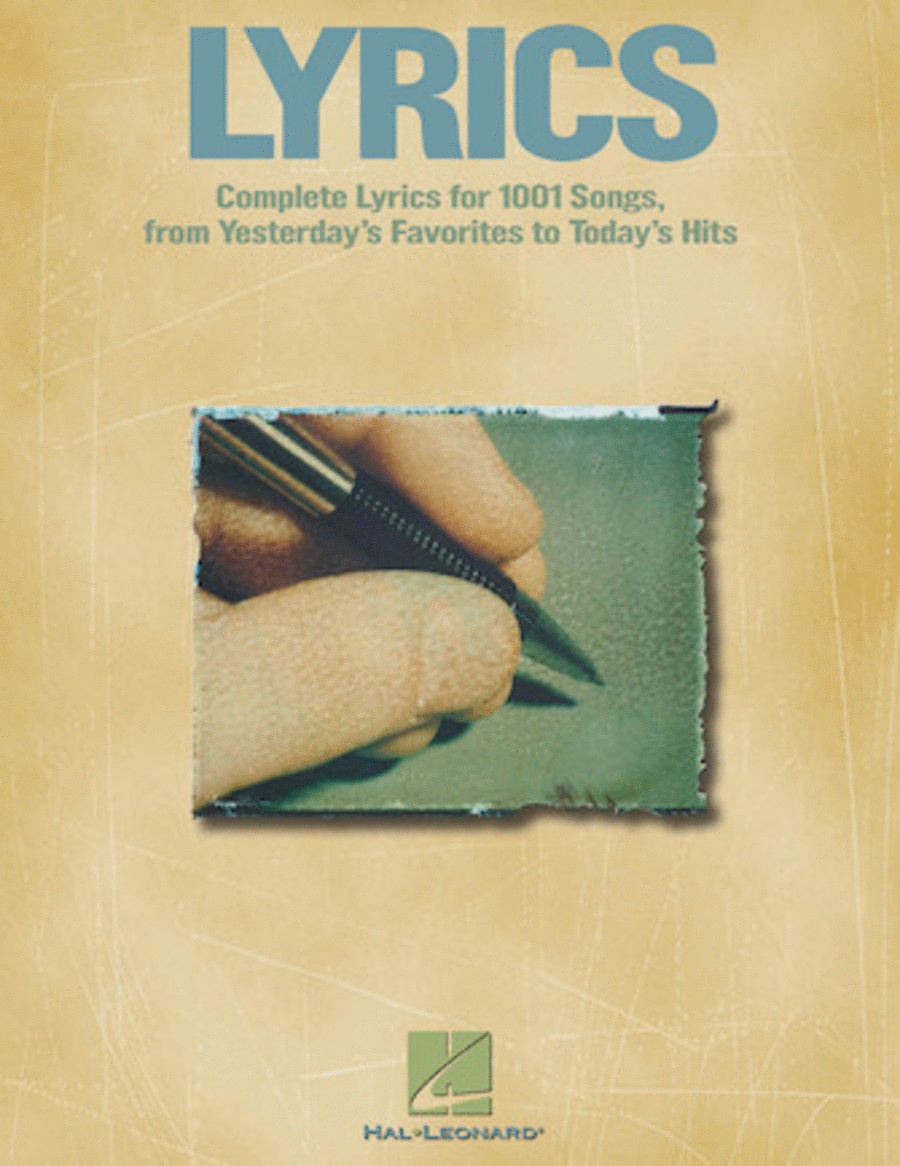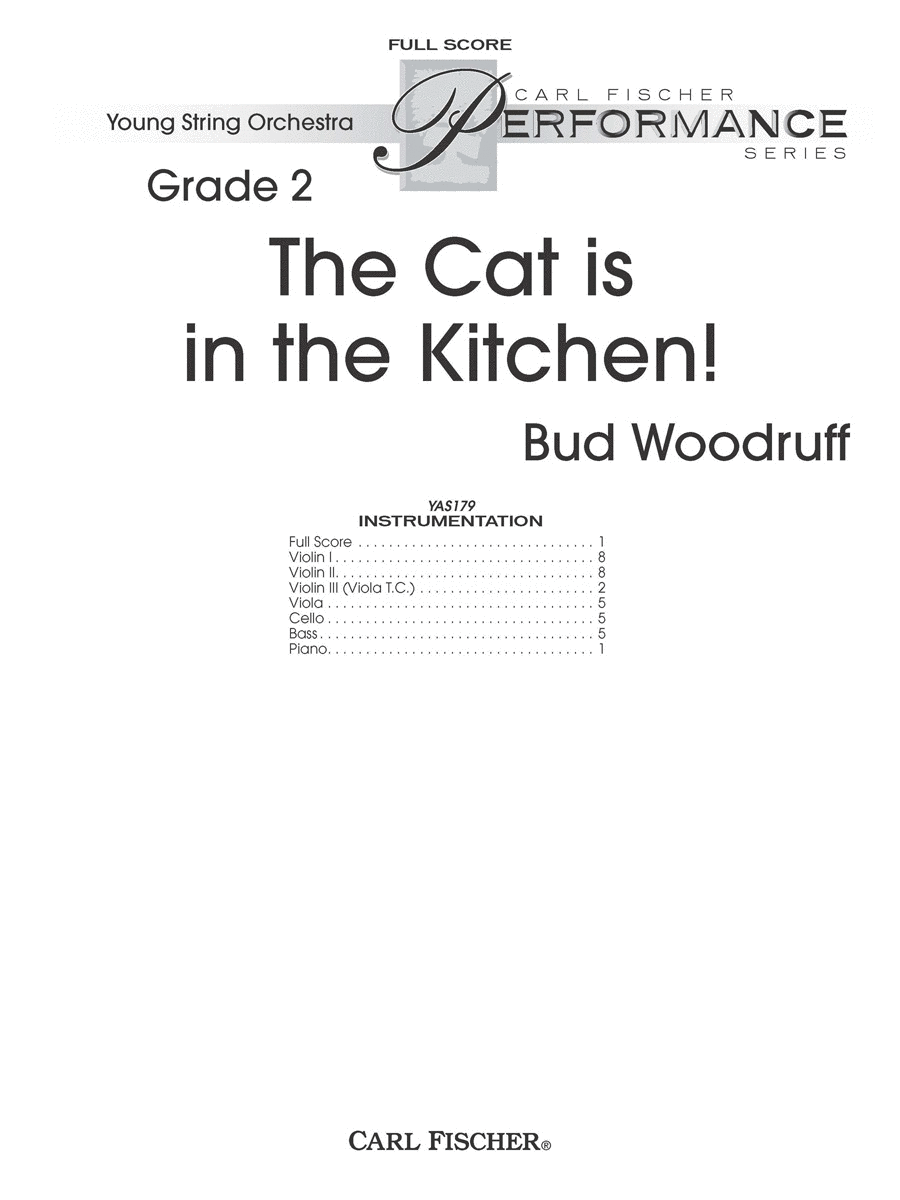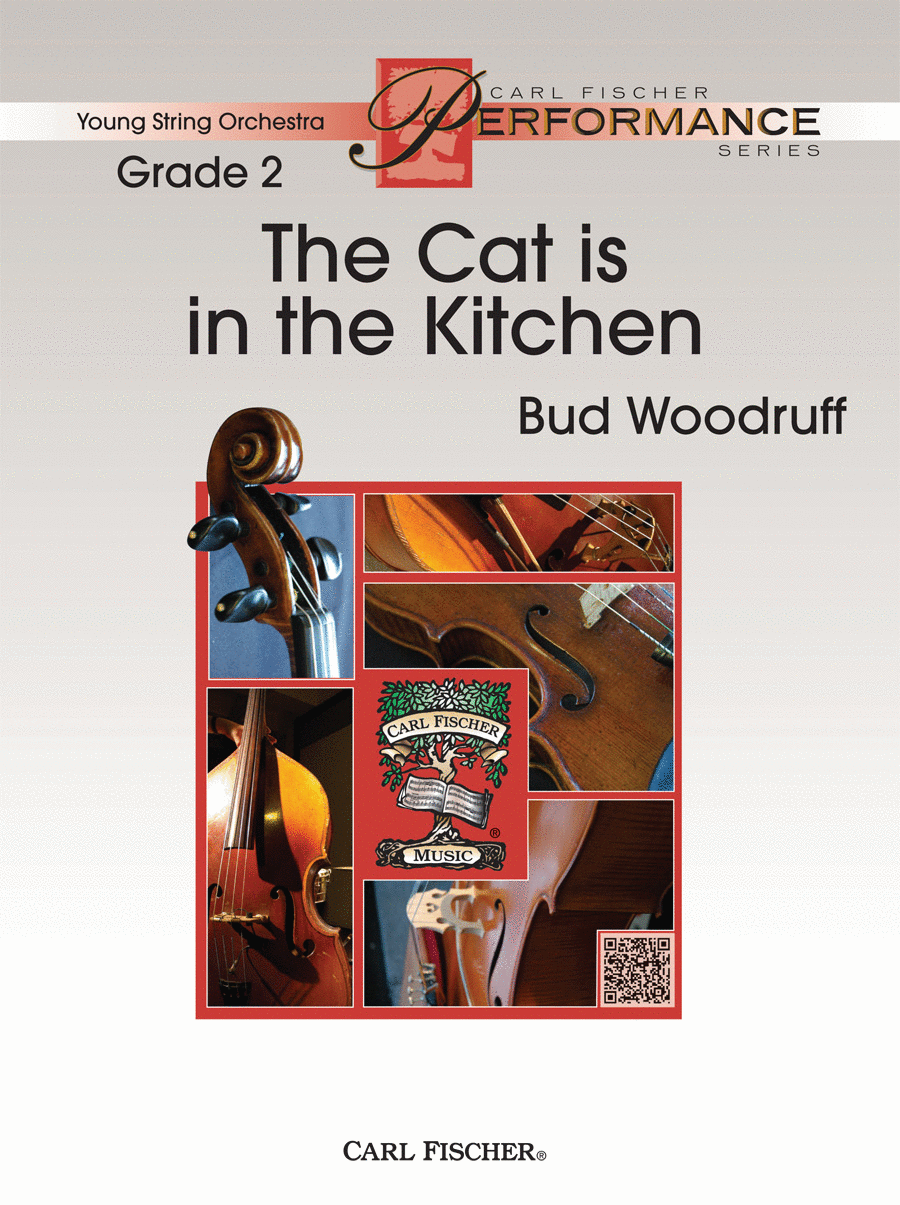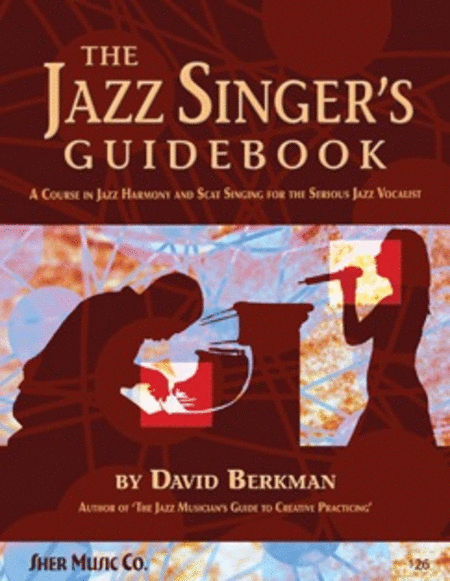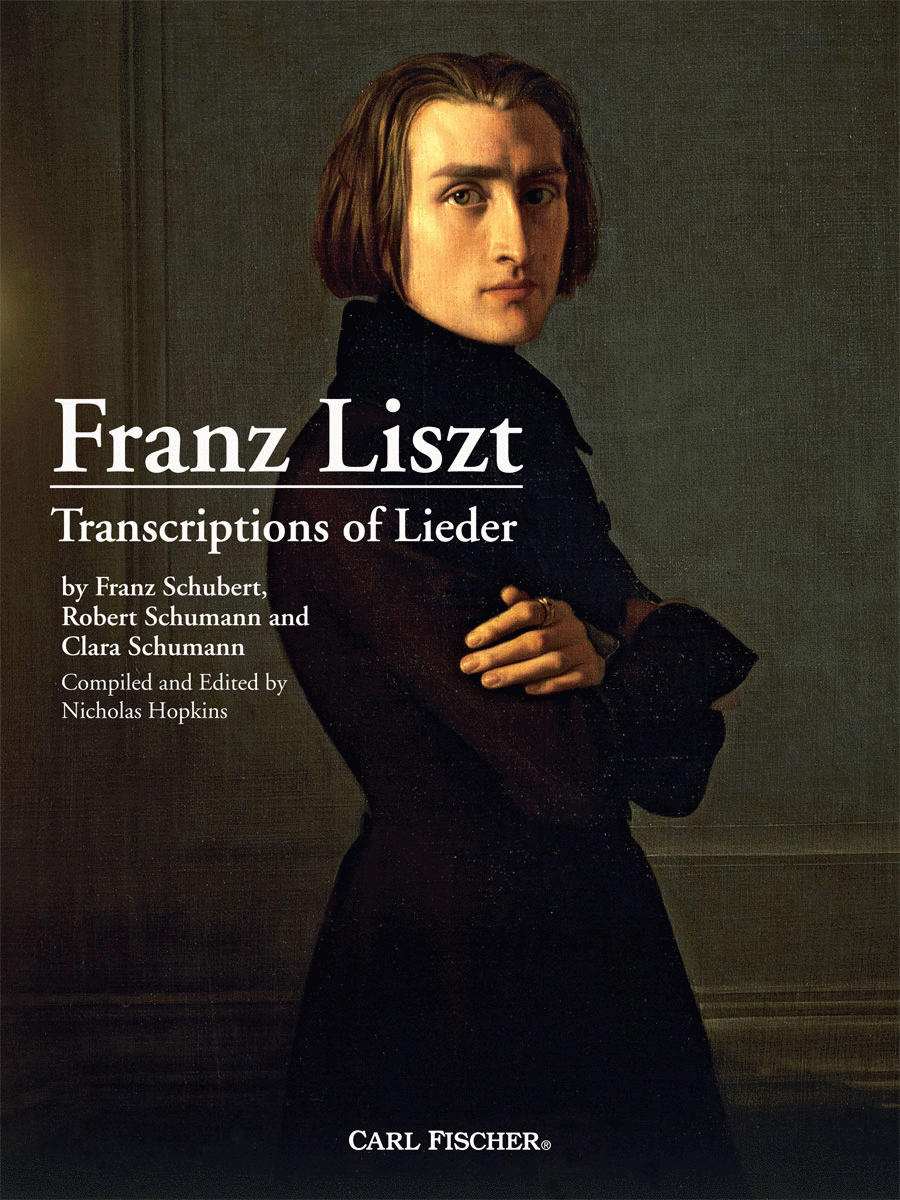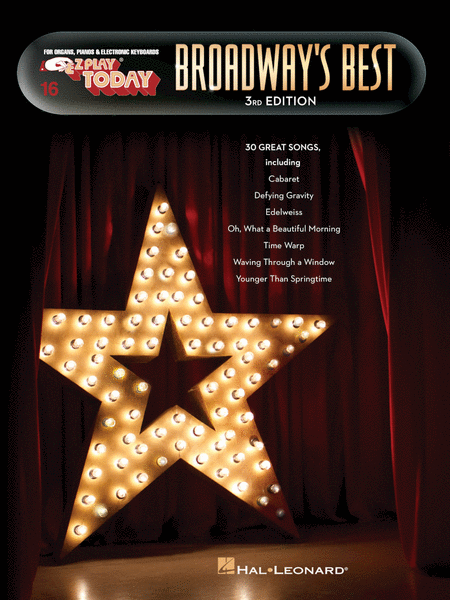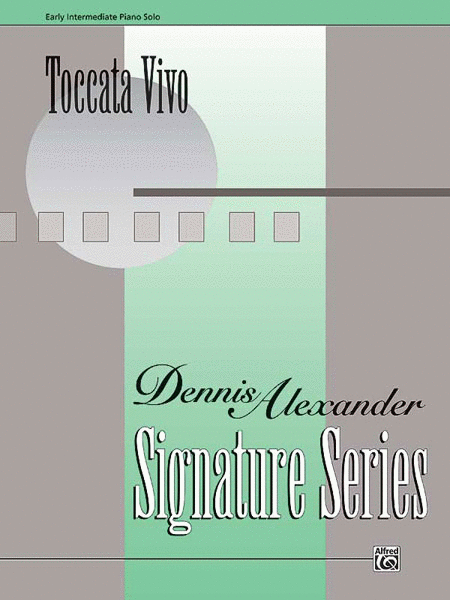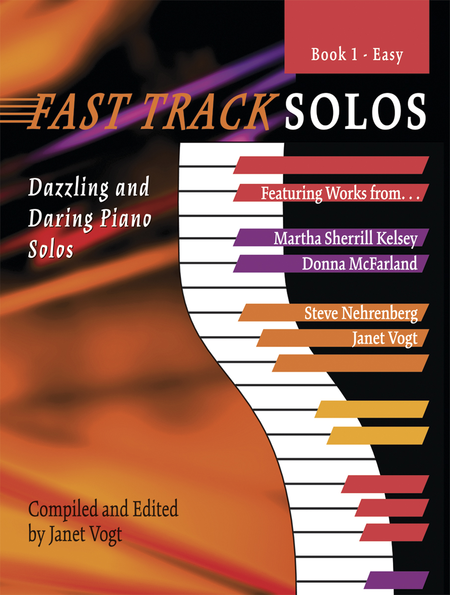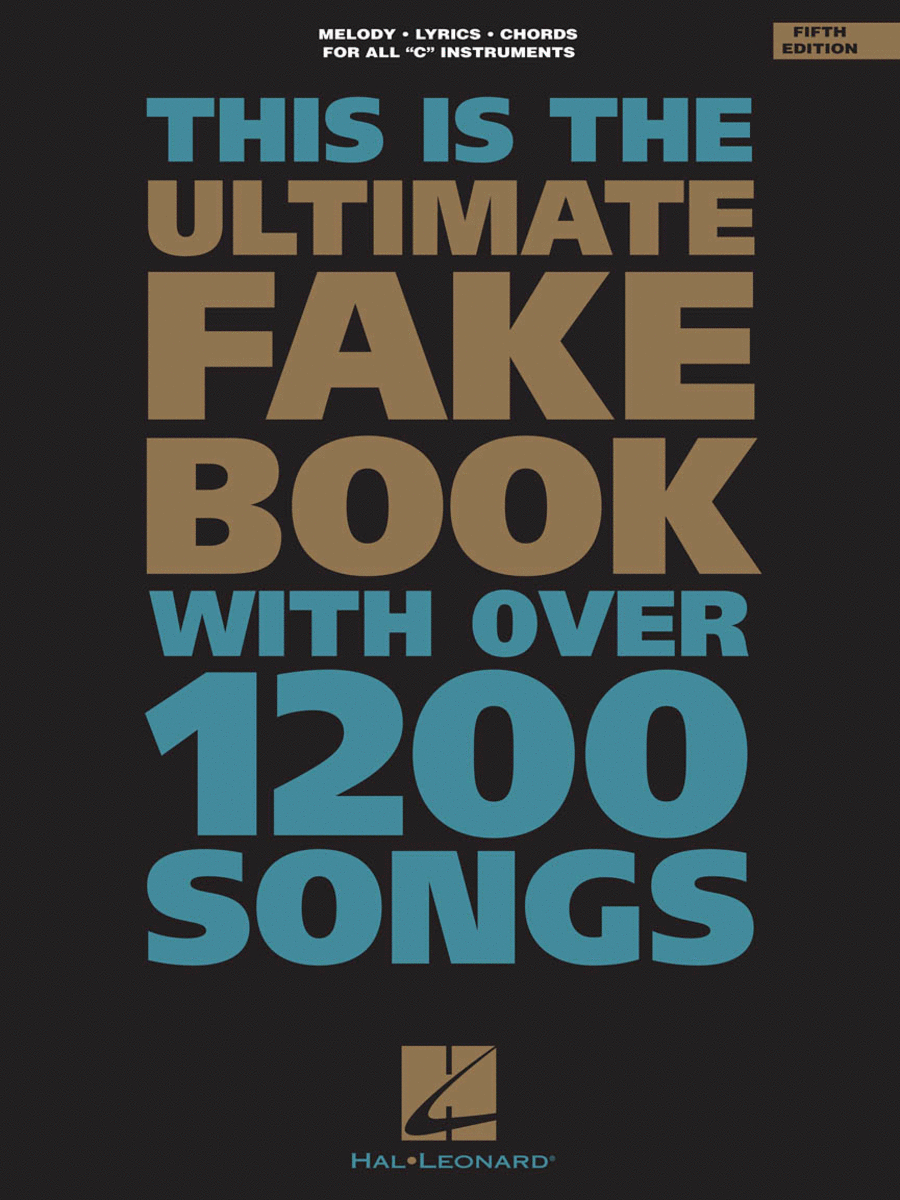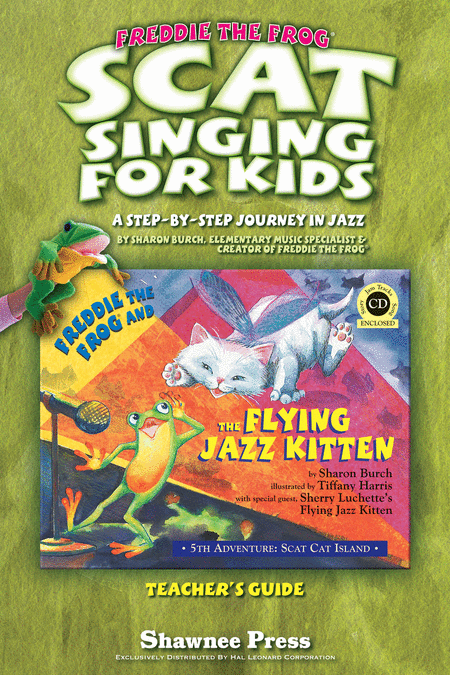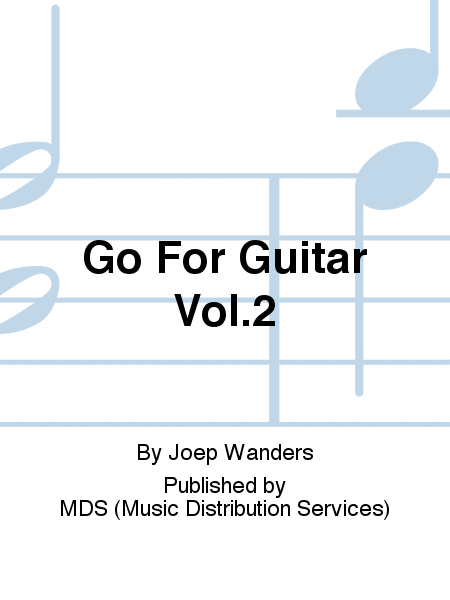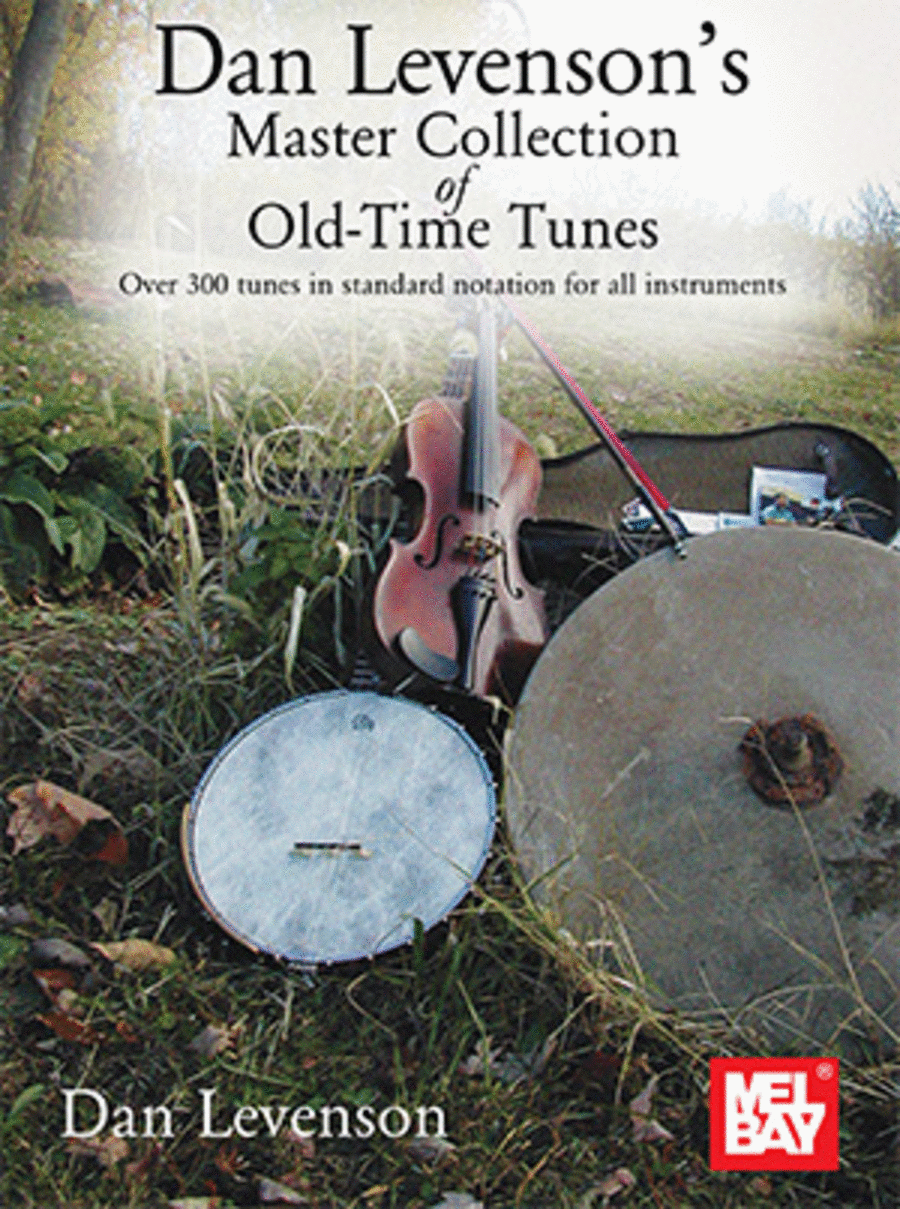|
| The Cat's Meow
Ensemble Jazz [Conducteur et Parties séparées] - Facile
Kjos Music Company
Band jazz ensemble - Grade 2.5 SKU: KJ.ZB369 Composed by Bruce Pearson an...(+)
Band jazz ensemble -
Grade 2.5 SKU:
KJ.ZB369 Composed by
Bruce Pearson and Dean
Sorenson. Standard of
Excellence Jazz Ensemble
Method. Jazz. Score and
parts. Neil A. Kjos Music
Company #ZB369. Published
by Neil A. Kjos Music
Company (KJ.ZB369).
ISBN 9788402701732.
UPC:
8402701736. The
Cat's Meow is
straight-ahead swinger in
the same vein as Benny
Golson's classic Killer
Joe. The melody is a very
simple riff that repeats
at different levels over
the course of the form.
The cat who inspired the
tune is a furry exotic
Persian named Berlioz who
took up residence in the
composer's house. Like
most cats, his life
consists mainly of eating
and sleeping. He most
often resides at the top
of the stairs, and never
bothers to try to get out
of the way.
About Standard
of Excellence Jazz
Ensemble
Method The
Standard of Excellence
Jazz Ensemble Method is
designed to help both you
and your jazz ensemble
students explore the
world of jazz through
easy-to-use Rhythm
Studies, Improvisation
Studies, Instrument
Specific Exercises, and
full ensemble jazz
charts. The approach is
non-theoretical and
aurally based. Each part
book comes with an
accompaniment CD, so like
every great jazz player
throughout history,
students learn to play
jazz by listening! $48.00 - Voir plus => AcheterDélais: 1 to 2 weeks | | | |
| The Lightning Catcher [Conducteur] - Facile
Carl Fischer
Orchestra Cello, Contrabass, Piano, Viola, Violin 1, Violin 2, Violin 3 - Grade ...(+)
Orchestra Cello,
Contrabass, Piano, Viola,
Violin 1, Violin 2,
Violin 3 - Grade 2
SKU: CF.YAS181F
Composed by Peter Terry.
Young String Orchestra
(YAS). Full score. With
Standard notation. 12
pages. Carl Fischer Music
#YAS181F. Published by
Carl Fischer Music
(CF.YAS181F). ISBN
9781491151839. UPC:
680160909339. 9 x 12
inches. Peter
Terry's The Lightning
Catcher celebrates youth
and the mysteries of
summer nights. The wonder
of lightning bugs and the
hours spent chasing,
catching, and releasing
them back are childhood
staples for many. With
bold gestures and
textures, this dramatic
piece takes the audience
back in time to the days
of their youth.
The
Lightning Catcher is
a piece that celebrates
youth and the mysteries
of a summer night.
These mysteries
include the wonder of
lightning bugs: spending
hours chasing them,
catching them in jars and
then releasing them back
into the night, only to
catch them again on
another perfect night.
Coupled with
this
experience are memories<
span class=s2> of summer
thunderstorms moving
across the Great Lakes
and a certain naive wish
that this too could be
caught in a glass jar for
later release.
The
Lightning Catcher is
a dramatic work with big,
bold gestures and
textures. Make sure that
you reserve enough volume
and energy to make the
ending the biggest point
in the piece.
I enjoyed
writing this piece and
hope your students will
enjoy playing these
contrasting styles and
that you will find the
piece beneficial in
teaching important
musical concepts.
Peter
Terry, 2018 . The
Lightning Catcher is
a piece that celebrates
youth and the mysteries
of a summer night.
These mysteries
include the wonder of
lightning bugs: spending
hours chasing them,
catching them in jars and
then releasing them back
into the night, only to
catch them again on
another perfect night.
Coupled with
this
experience are memories<
span class=s2> of summer
thunderstorms moving
across the Great Lakes
and a certain naA-ve wish
that this too could be
caught in a glass jar for
later release.
The
Lightning Catcher is
a dramatic work with big,
bold gestures and
textures. Make sure that
you reserve enough volume
and energy to make the
ending the biggest point
in the piece.
I enjoyed
writing this piece and
hope your students will
enjoy playing these
contrasting styles and
that you will find the
piece beneficial in
teaching important
musical concepts.
Peter
Terry, 2018 . The
Lightning Catcher is
a piece that celebrates
youth and the mysteries
of a summer night.
These mysteries
include the wonder of
lightning bugs: spending
hours chasing them,
catching them in jars and
then releasing them back
into the night, only to
catch them again on
another perfect night.
Coupled with
this
experience are memories<
span class=s2> of summer
thunderstorms moving
across the Great Lakes
and a certain naA-ve wish
that this too could be
caught in a glass jar for
later release.
The
Lightning Catcher is
a dramatic work with big,
bold gestures and
textures. Make sure that
you reserve enough volume
and energy to make the
ending the biggest point
in the piece.
I enjoyed
writing this piece and
hope your students will
enjoy playing these
contrasting styles and
that you will find the
piece beneficial in
teaching important
musical concepts.
Peter
Terry, 2018 . The
Lightning Catcher is
a piece that celebrates
youth and the mysteries
of a summer night.
These mysteries
include the wonder of
lightning bugs: spending
hours chasing them,
catching them in jars and
then releasing them back
into the night, only to
catch them again on
another perfect night.
Coupled with
this
experience are memories<
span class=s2> of summer
thunderstorms moving
across the Great Lakes
and a certain naive wish
that this too could be
caught in a glass jar for
later release.
The
Lightning Catcher is
a dramatic work with big,
bold gestures and
textures. Make sure that
you reserve enough volume
and energy to make the
ending the biggest point
in the piece.
I enjoyed
writing this piece and
hope your students will
enjoy playing these
contrasting styles and
that you will find the
piece beneficial in
teaching important
musical concepts.
Peter
Terry, 2018 . The Lightning Catcher is
a piece that celebrates
youth and the mysteries
of a summer night. These
mysteries include the
wonder of lightning bugs:
spending hours chasing
them, catching them in
jars and then releasing
them back into the night,
only to catch them again
on another perfect night.
Coupled with this
experience are memories
of summer thunderstorms
moving across the Great
Lakes and a certain naive
wish that this too could
be caught in a glass jar
for later release. The
Lightning Catcher is a
dramatic work with big,
bold gestures and
textures. Make sure that
you reserve enough volume
and energy to make the
ending the biggest point
in the piece. I enjoyed
writing this piece and
hope your students will
enjoy playing these
contrasting styles and
that you will find the
piece beneficial in
teaching important
musical concepts. Peter
Terry, 2018. The
Lightning Catcher is a
piece that celebrates
youth and the mysteries
of a summer night. These
mysteries include the
wonder of lightning bugs:
spending hours chasing
them, catching them in
jars and then releasing
them back into the night,
only to catch them again
on another perfect night.
Coupled with this
experience are memories
of summer thunderstorms
moving across the Great
Lakes and a certain
naïve wish that this
too could be caught in a
glass jar for later
release.The Lightning
Catcher is a dramatic
work with big, bold
gestures and textures.
Make sure that you
reserve enough volume and
energy to make the ending
the biggest point in the
piece.I enjoyed writing
this piece and hope your
students will enjoy
playing these contrasting
styles and that you will
find the piece beneficial
in teaching important
musical concepts.Peter
Terry, 2018.
About Carl
Fischer Young String
Orchestra
Series Thi
s series of Grade 2/Grade
2.5 pieces is designed
for second and third year
ensembles. The pieces in
this series are
characterized
by:
--Occasionally
extending to third
position
--Keys
carefully considered for
appropriate
difficulty
--Addition
of separate 2nd violin
and viola
parts
--Viola T.C.
part
included
--Increase
in independence of parts
over beginning levels $8.50 - Voir plus => AcheterDélais: 1 to 2 weeks | | | |
| The Lightning Catcher - Facile
Carl Fischer
Orchestra Cello, Contrabass, Piano, Viola, Violin 1, Violin 2, Violin 3 - Grade ...(+)
Orchestra Cello,
Contrabass, Piano, Viola,
Violin 1, Violin 2,
Violin 3 - Grade 2
SKU: CF.YAS181
Composed by Peter Terry.
Young String Orchestra.
Set of Score and Parts.
With Standard notation.
8+8+5+5+2+2+5+12 pages.
Duration 2 minutes, 3
seconds. Carl Fischer
Music #YAS181. Published
by Carl Fischer Music
(CF.YAS181). ISBN
9781491151464. UPC:
680160908967. 9 x 12
inches. Key: B
minor. Peter
Terry's The Lightning
Catcher celebrates youth
and the mysteries of
summer nights. The wonder
of lightning bugs and the
hours spent chasing,
catching, and releasing
them back are childhood
staples for many. With
bold gestures and
textures, this dramatic
piece takes the audience
back in time to the days
of their youth.
The
Lightning Catcher is
a piece that celebrates
youth and the mysteries
of a summer night.
These mysteries
include the wonder of
lightning bugs: spending
hours chasing them,
catching them in jars and
then releasing them back
into the night, only to
catch them again on
another perfect night.
Coupled with
this
experience are memories<
span class=s2> of summer
thunderstorms moving
across the Great Lakes
and a certain naive wish
that this too could be
caught in a glass jar for
later release.
The
Lightning Catcher is
a dramatic work with big,
bold gestures and
textures. Make sure that
you reserve enough volume
and energy to make the
ending the biggest point
in the piece.
I enjoyed
writing this piece and
hope your students will
enjoy playing these
contrasting styles and
that you will find the
piece beneficial in
teaching important
musical concepts.
Peter
Terry, 2018 . The
Lightning Catcher is
a piece that celebrates
youth and the mysteries
of a summer night.
These mysteries
include the wonder of
lightning bugs: spending
hours chasing them,
catching them in jars and
then releasing them back
into the night, only to
catch them again on
another perfect night.
Coupled with
this
experience are memories<
span class=s2> of summer
thunderstorms moving
across the Great Lakes
and a certain naA-ve wish
that this too could be
caught in a glass jar for
later release.
The
Lightning Catcher is
a dramatic work with big,
bold gestures and
textures. Make sure that
you reserve enough volume
and energy to make the
ending the biggest point
in the piece.
I enjoyed
writing this piece and
hope your students will
enjoy playing these
contrasting styles and
that you will find the
piece beneficial in
teaching important
musical concepts.
Peter
Terry, 2018 . The
Lightning Catcher is
a piece that celebrates
youth and the mysteries
of a summer night.
These mysteries
include the wonder of
lightning bugs: spending
hours chasing them,
catching them in jars and
then releasing them back
into the night, only to
catch them again on
another perfect night.
Coupled with
this
experience are memories<
span class=s2> of summer
thunderstorms moving
across the Great Lakes
and a certain naA-ve wish
that this too could be
caught in a glass jar for
later release.
The
Lightning Catcher is
a dramatic work with big,
bold gestures and
textures. Make sure that
you reserve enough volume
and energy to make the
ending the biggest point
in the piece.
I enjoyed
writing this piece and
hope your students will
enjoy playing these
contrasting styles and
that you will find the
piece beneficial in
teaching important
musical concepts.
Peter
Terry, 2018 . The
Lightning Catcher is
a piece that celebrates
youth and the mysteries
of a summer night.
These mysteries
include the wonder of
lightning bugs: spending
hours chasing them,
catching them in jars and
then releasing them back
into the night, only to
catch them again on
another perfect night.
Coupled with
this
experience are memories<
span class=s2> of summer
thunderstorms moving
across the Great Lakes
and a certain naive wish
that this too could be
caught in a glass jar for
later release.
The
Lightning Catcher is
a dramatic work with big,
bold gestures and
textures. Make sure that
you reserve enough volume
and energy to make the
ending the biggest point
in the piece.
I enjoyed
writing this piece and
hope your students will
enjoy playing these
contrasting styles and
that you will find the
piece beneficial in
teaching important
musical concepts.
Peter
Terry, 2018 . The Lightning Catcher is
a piece that celebrates
youth and the mysteries
of a summer night. These
mysteries include the
wonder of lightning bugs:
spending hours chasing
them, catching them in
jars and then releasing
them back into the night,
only to catch them again
on another perfect night.
Coupled with this
experience are memories
of summer thunderstorms
moving across the Great
Lakes and a certain naive
wish that this too could
be caught in a glass jar
for later release. The
Lightning Catcher is a
dramatic work with big,
bold gestures and
textures. Make sure that
you reserve enough volume
and energy to make the
ending the biggest point
in the piece. I enjoyed
writing this piece and
hope your students will
enjoy playing these
contrasting styles and
that you will find the
piece beneficial in
teaching important
musical concepts. Peter
Terry, 2018. The
Lightning Catcher is a
piece that celebrates
youth and the mysteries
of a summer night. These
mysteries include the
wonder of lightning bugs:
spending hours chasing
them, catching them in
jars and then releasing
them back into the night,
only to catch them again
on another perfect night.
Coupled with this
experience are memories
of summer thunderstorms
moving across the Great
Lakes and a certain
naïve wish that this
too could be caught in a
glass jar for later
release.The Lightning
Catcher is a dramatic
work with big, bold
gestures and textures.
Make sure that you
reserve enough volume and
energy to make the ending
the biggest point in the
piece.I enjoyed writing
this piece and hope your
students will enjoy
playing these contrasting
styles and that you will
find the piece beneficial
in teaching important
musical concepts.Peter
Terry, 2018.
About Carl
Fischer Young String
Orchestra
Series Thi
s series of Grade 2/Grade
2.5 pieces is designed
for second and third year
ensembles. The pieces in
this series are
characterized
by:
--Occasionally
extending to third
position
--Keys
carefully considered for
appropriate
difficulty
--Addition
of separate 2nd violin
and viola
parts
--Viola T.C.
part
included
--Increase
in independence of parts
over beginning levels $55.00 - Voir plus => AcheterDélais: 1 to 2 weeks | | | |
| Appalachian Fiddle Music
Violon
Mel Bay
Fiddle - Beginning; Intermediate; Advanced SKU: MB.30091 Featuring 43 ...(+)
Fiddle - Beginning;
Intermediate; Advanced
SKU: MB.30091
Featuring 43 Fiddlers
and 188 of Their
Tunes. Perfect
binding. Folk. Book. 212
pages. Mel Bay
Publications, Inc #30091.
Published by Mel Bay
Publications, Inc
(MB.30091). ISBN
9781513466378. 8.75 x
11.75
inches. Appalachian
fiddle music, based on
the musical traditions of
the people who settled in
the mountainous regions
of the southeastern
United States, is
widely-known and played
throughout North America
and parts of Europe
because of its complex
rhythms, its catchy
melodies, and its
often-ancient-sounding
stylistic qualities. The
authors explore the lives
and music of 43 of the
classic Appalachian
fiddlers who were active
during the first half of
the 20th century. Some of
them were recorded
commercially in the
1920s, such as Gid
Tanner, Fiddlin? John
Carson, and Charlie
Bowman. Some were
recorded by folklorists
from the Library of
Congress, such as William
Stepp, Emmett Lundy, and
Marion Reece. Others were
recorded informally by
family members and
visitors, such as John
Salyer, Emma Lee
Dickerson, and Manco
Sneed. All of them played
throughout most of their
lives and influenced the
growth and stylistic
elements of fiddle music
in their regions. Each
fiddler has been given a
chapter with a biography,
several tune
transcriptions, and tune
histories. To show the
richness of the music,
the authors make a
special effort to show
the musical elements in
detail, but also
acknowledge that nothing
can take the place of
listening. Many of the
classic recordings used
in this book can be found
on the web, allowing you
to hear and read the
music together. $24.99 - Voir plus => AcheterDélais: 1 to 2 weeks | | | |
| Lyrics
Paroles Seulement [Partition]
Hal Leonard
Complete Lyrics for Over 1000 Songs from Broadway to Rock. By Various. Lyric Lib...(+)
Complete Lyrics for Over
1000 Songs from Broadway
to Rock. By Various.
Lyric Library. Softcover.
Size 8.5x11 inches. 373
pages. Published by Hal
Leonard.
(1)$29.99 - Voir plus => AcheterDélais: 24 hours - In Stock | | | |
| The Cat Is in the Kitchen [Conducteur] - Facile
Carl Fischer
Orchestra Cello, Contrabass, Piano, Viola, Violin 1, Violin 2, Violin 3 - Grade ...(+)
Orchestra Cello,
Contrabass, Piano, Viola,
Violin 1, Violin 2,
Violin 3 - Grade 2
SKU: CF.YAS179F
Composed by Bud Woodruff.
Young String Orchestra
(YAS). Full score. With
Standard notation. 12
pages. Carl Fischer Music
#YAS179F. Published by
Carl Fischer Music
(CF.YAS179F). ISBN
9781491151815. UPC:
680160909315. 9 x 12
inches. Key: F
major. Bud Woodruff
presents The Cat Is in
the Kitchen, a
tongue-in-cheek style
piece with jazz
influences that students
enjoy playing. This
quirky piece is designed
to help students
successfully navigate
playing F-naturals and
B-flats. Bud Woodruff
draws on his lengthy
career as a string
educator to help students
overcome the challenges
in this piece.
I wrote The
Cat Is in the
Kitchen for a group
of very talented young
players who, for some
reason, did not like
Bb's, and particularly
Bb's on the G string ...
especially the cellos
(who always faithfully
played them as B
naturals). They bore no
great love for F
naturals, either. So this
piece is full of both.
Since the students liked
the sound of the piece,
they overcame their
dislikes, and all was
just fine in the end ...
mission accomplished!
One will
find that changing the
bowings will change the
accents, too, and the
flavor of the piece will
be lost. Without a doubt,
there is a jazz
influence, and the piece
will be easier to teach
if you approach it from
that angle. Have the
class work on m. 18 until
everyone can play it
ease. Then add m. 19 for
the upper strings, and
90% of any issues the
bowings may present will
be solved. My kids loved
playing this piece, and
the audience enjoyed
hearing it. I trust you
will have the same
results. . I wrote The
Cat Is in the
KitchenA for a group
of very talented young
players who, for some
reason, did not like
Bb's, and particularly
Bb's on the G string ...
especially the cellos
(who always faithfully
played them as B
naturals). They bore no
great love for F
naturals, either. So this
piece is full of both.
Since the students liked
the sound of the piece,
they overcame their
dislikes, and all was
just fine in the end ...
mission accomplished!
A One will
find that changing the
bowings will change the
accents, too, and the
flavor of the piece will
be lost. Without a doubt,
there is a jazz
influence, and the piece
will be easier to teach
if you approach it from
that angle. Have the
class work on m. 18 until
everyone can play it
ease. Then add m. 19 for
the upper strings, and
90% of any issues the
bowings may present will
be solved. A My kids loved
playing this piece, and
the audience enjoyed
hearing it. I trust you
will have the same
results. . I wrote The
Cat Is in the
KitchenA for a group
of very talented young
players who, for some
reason, did not like
Bb's, and particularly
Bb's on the G string ...
especially the cellos
(who always faithfully
played them as B
naturals). They bore no
great love for F
naturals, either. So this
piece is full of both.
Since the students liked
the sound of the piece,
they overcame their
dislikes, and all was
just fine in the end ...
mission accomplished!
A One will
find that changing the
bowings will change the
accents, too, and the
flavor of the piece will
be lost. Without a doubt,
there is a jazz
influence, and the piece
will be easier to teach
if you approach it from
that angle. Have the
class work on m. 18 until
everyone can play it
ease. Then add m. 19 for
the upper strings, and
90% of any issues the
bowings may present will
be solved. A My kids loved
playing this piece, and
the audience enjoyed
hearing it. I trust you
will have the same
results. . I wrote The
Cat Is in the
Kitchen for a group
of very talented young
players who, for some
reason, did not like
Bb's, and particularly
Bb's on the G string ...
especially the cellos
(who always faithfully
played them as B
naturals). They bore no
great love for F
naturals, either. So this
piece is full of both.
Since the students liked
the sound of the piece,
they overcame their
dislikes, and all was
just fine in the end ...
mission accomplished!
One will
find that changing the
bowings will change the
accents, too, and the
flavor of the piece will
be lost. Without a doubt,
there is a jazz
influence, and the piece
will be easier to teach
if you approach it from
that angle. Have the
class work on m. 18 until
everyone can play it
ease. Then add m. 19 for
the upper strings, and
90% of any issues the
bowings may present will
be solved. My kids loved
playing this piece, and
the audience enjoyed
hearing it. I trust you
will have the same
results. . I wrote
The Cat Is in the Kitchen
for a group of very
talented young players
who, for some reason, did
not like Bb's, and
particularly Bb's on the
G string ... especially
the cellos (who always
faithfully played them as
B naturals). They bore no
great love for F
naturals, either. So this
piece is full of both.
Since the students liked
the sound of the piece,
they overcame their
dislikes, and all was
just fine in the end ...
mission accomplished! One
will find that changing
the bowings will change
the accents, too, and the
flavor of the piece will
be lost. Without a doubt,
there is a jazz
influence, and the piece
will be easier to teach
if you approach it from
that angle. Have the
class work on m. 18 until
everyone can play it
ease. Then add m. 19 for
the upper strings, and
90% of any issues the
bowings may present will
be solved. My kids loved
playing this piece, and
the audience enjoyed
hearing it. I trust you
will have the same
results. I wrote The
Cat Is in the
Kitchen for a group of
very talented young
players who, for some
reason, did not like
Bb's, and particularly
Bb's on the G string ...
especially the cellos
(who always faithfully
played them as B
naturals). They bore no
great love for F
naturals, either. So this
piece is full of both.
Since the students liked
the sound of the piece,
they overcame their
dislikes, and all was
just fine in the end ...
mission
accomplished! One will
find that changing the
bowings will change the
accents, too, and the
flavor of the piece will
be lost. Without a doubt,
there is a jazz
influence, and the piece
will be easier to teach
if you approach it from
that angle. Have the
class work on m. 18 until
everyone can play it
ease. Then add m. 19 for
the upper strings, and
90% of any issues the
bowings may present will
be solved. My kids
loved playing this piece,
and the audience enjoyed
hearing it. I trust you
will have the same
results.
About Carl
Fischer Young String
Orchestra
Series Thi
s series of Grade 2/Grade
2.5 pieces is designed
for second and third year
ensembles. The pieces in
this series are
characterized
by:
--Occasionally
extending to third
position
--Keys
carefully considered for
appropriate
difficulty
--Addition
of separate 2nd violin
and viola
parts
--Viola T.C.
part
included
--Increase
in independence of parts
over beginning levels $8.50 - Voir plus => AcheterDélais: 1 to 2 weeks | | | |
| The Cat Is in the Kitchen - Facile
Carl Fischer
Orchestra Cello, Contrabass, Piano, Viola, Violin 1, Violin 2, Violin 3 - Grade ...(+)
Orchestra Cello,
Contrabass, Piano, Viola,
Violin 1, Violin 2,
Violin 3 - Grade 2
SKU: CF.YAS179
Composed by Bud Woodruff.
Young String Orchestra.
Set of Score and Parts.
With Standard notation.
8+8+5+2+5+5+3+12 pages.
Duration 2 minutes, 18
seconds. Carl Fischer
Music #YAS179. Published
by Carl Fischer Music
(CF.YAS179). ISBN
9781491151440. UPC:
680160908943. 9 x 12
inches. Key: C
major. Bud Woodruff
presents The Cat Is in
the Kitchen, a
tongue-in-cheek style
piece with jazz
influences that students
enjoy playing. This
quirky piece is designed
to help students
successfully navigate
playing F-naturals and
B-flats. Bud Woodruff
draws on his lengthy
career as a string
educator to help students
overcome the challenges
in this piece.
I wrote The
Cat Is in the
Kitchen for a group
of very talented young
players who, for some
reason, did not like
Bb's, and particularly
Bb's on the G string ...
especially the cellos
(who always faithfully
played them as B
naturals). They bore no
great love for F
naturals, either. So this
piece is full of both.
Since the students liked
the sound of the piece,
they overcame their
dislikes, and all was
just fine in the end ...
mission accomplished!
One will
find that changing the
bowings will change the
accents, too, and the
flavor of the piece will
be lost. Without a doubt,
there is a jazz
influence, and the piece
will be easier to teach
if you approach it from
that angle. Have the
class work on m. 18 until
everyone can play it
ease. Then add m. 19 for
the upper strings, and
90% of any issues the
bowings may present will
be solved. My kids loved
playing this piece, and
the audience enjoyed
hearing it. I trust you
will have the same
results. . I wrote The
Cat Is in the
KitchenA for a group
of very talented young
players who, for some
reason, did not like
Bb's, and particularly
Bb's on the G string ...
especially the cellos
(who always faithfully
played them as B
naturals). They bore no
great love for F
naturals, either. So this
piece is full of both.
Since the students liked
the sound of the piece,
they overcame their
dislikes, and all was
just fine in the end ...
mission accomplished!
A One will
find that changing the
bowings will change the
accents, too, and the
flavor of the piece will
be lost. Without a doubt,
there is a jazz
influence, and the piece
will be easier to teach
if you approach it from
that angle. Have the
class work on m. 18 until
everyone can play it
ease. Then add m. 19 for
the upper strings, and
90% of any issues the
bowings may present will
be solved. A My kids loved
playing this piece, and
the audience enjoyed
hearing it. I trust you
will have the same
results. . I wrote The
Cat Is in the
KitchenA for a group
of very talented young
players who, for some
reason, did not like
Bb's, and particularly
Bb's on the G string ...
especially the cellos
(who always faithfully
played them as B
naturals). They bore no
great love for F
naturals, either. So this
piece is full of both.
Since the students liked
the sound of the piece,
they overcame their
dislikes, and all was
just fine in the end ...
mission accomplished!
A One will
find that changing the
bowings will change the
accents, too, and the
flavor of the piece will
be lost. Without a doubt,
there is a jazz
influence, and the piece
will be easier to teach
if you approach it from
that angle. Have the
class work on m. 18 until
everyone can play it
ease. Then add m. 19 for
the upper strings, and
90% of any issues the
bowings may present will
be solved. A My kids loved
playing this piece, and
the audience enjoyed
hearing it. I trust you
will have the same
results. . I wrote The
Cat Is in the
Kitchen for a group
of very talented young
players who, for some
reason, did not like
Bb's, and particularly
Bb's on the G string ...
especially the cellos
(who always faithfully
played them as B
naturals). They bore no
great love for F
naturals, either. So this
piece is full of both.
Since the students liked
the sound of the piece,
they overcame their
dislikes, and all was
just fine in the end ...
mission accomplished!
One will
find that changing the
bowings will change the
accents, too, and the
flavor of the piece will
be lost. Without a doubt,
there is a jazz
influence, and the piece
will be easier to teach
if you approach it from
that angle. Have the
class work on m. 18 until
everyone can play it
ease. Then add m. 19 for
the upper strings, and
90% of any issues the
bowings may present will
be solved. My kids loved
playing this piece, and
the audience enjoyed
hearing it. I trust you
will have the same
results. . I wrote
The Cat Is in the Kitchen
for a group of very
talented young players
who, for some reason, did
not like Bb's, and
particularly Bb's on the
G string ... especially
the cellos (who always
faithfully played them as
B naturals). They bore no
great love for F
naturals, either. So this
piece is full of both.
Since the students liked
the sound of the piece,
they overcame their
dislikes, and all was
just fine in the end ...
mission accomplished! One
will find that changing
the bowings will change
the accents, too, and the
flavor of the piece will
be lost. Without a doubt,
there is a jazz
influence, and the piece
will be easier to teach
if you approach it from
that angle. Have the
class work on m. 18 until
everyone can play it
ease. Then add m. 19 for
the upper strings, and
90% of any issues the
bowings may present will
be solved. My kids loved
playing this piece, and
the audience enjoyed
hearing it. I trust you
will have the same
results. I wrote The
Cat Is in the
Kitchen for a group of
very talented young
players who, for some
reason, did not like
Bb's, and particularly
Bb's on the G string ...
especially the cellos
(who always faithfully
played them as B
naturals). They bore no
great love for F
naturals, either. So this
piece is full of both.
Since the students liked
the sound of the piece,
they overcame their
dislikes, and all was
just fine in the end ...
mission
accomplished! One will
find that changing the
bowings will change the
accents, too, and the
flavor of the piece will
be lost. Without a doubt,
there is a jazz
influence, and the piece
will be easier to teach
if you approach it from
that angle. Have the
class work on m. 18 until
everyone can play it
ease. Then add m. 19 for
the upper strings, and
90% of any issues the
bowings may present will
be solved. My kids
loved playing this piece,
and the audience enjoyed
hearing it. I trust you
will have the same
results.
About Carl
Fischer Young String
Orchestra
Series Thi
s series of Grade 2/Grade
2.5 pieces is designed
for second and third year
ensembles. The pieces in
this series are
characterized
by:
--Occasionally
extending to third
position
--Keys
carefully considered for
appropriate
difficulty
--Addition
of separate 2nd violin
and viola
parts
--Viola T.C.
part
included
--Increase
in independence of parts
over beginning levels $55.00 - Voir plus => AcheterDélais: 24 hours - In Stock | | | |
| The Jazz Singer's Guidebook
Livre + CD [CD]
Sher Music Company
(A course in jazz harmony and scat singing for the serious jazz vocalist). By Da...(+)
(A course in jazz harmony
and scat singing for the
serious jazz vocalist).
By David Berkman.
Instructional. Book and
CD. 142 pages. Published
by Sher Music Company
$26.00 - Voir plus => AcheterDélais: 1 to 2 weeks | | | |
| Transcriptions of Lieder
Piano seul
Carl Fischer
Chamber Music Piano SKU: CF.PL1056 Composed by Clara Wieck-Schumann, Fran...(+)
Chamber Music Piano
SKU: CF.PL1056
Composed by Clara
Wieck-Schumann, Franz
Schubert, and Robert
Schumann. Edited by
Nicholas Hopkins.
Collection. With Standard
notation. 128 pages. Carl
Fischer Music #PL1056.
Published by Carl Fischer
Music (CF.PL1056).
ISBN 9781491153390.
UPC: 680160910892.
Transcribed by Franz
Liszt. Introduction
It is true that Schubert
himself is somewhat to
blame for the very
unsatisfactory manner in
which his admirable piano
pieces are treated. He
was too immoderately
productive, wrote
incessantly, mixing
insignificant with
important things, grand
things with mediocre
work, paid no heed to
criticism, and always
soared on his wings. Like
a bird in the air, he
lived in music and sang
in angelic fashion.
--Franz Liszt, letter to
Dr. S. Lebert (1868) Of
those compositions that
greatly interest me,
there are only Chopin's
and yours. --Franz Liszt,
letter to Robert Schumann
(1838) She [Clara
Schumann] was astounded
at hearing me. Her
compositions are really
very remarkable,
especially for a woman.
There is a hundred times
more creativity and real
feeling in them than in
all the past and present
fantasias by Thalberg.
--Franz Liszt, letter to
Marie d'Agoult (1838)
Chretien Urhan
(1790-1845) was a
Belgian-born violinist,
organist and composer who
flourished in the musical
life of Paris in the
early nineteenth century.
According to various
accounts, he was deeply
religious, harshly
ascetic and wildly
eccentric, though revered
by many important and
influential members of
the Parisian musical
community. Regrettably,
history has forgotten
Urhan's many musical
achievements, the most
important of which was
arguably his pioneering
work in promoting the
music of Franz Schubert.
He devoted much of his
energies to championing
Schubert's music, which
at the time was unknown
outside of Vienna.
Undoubtedly, Urhan was
responsible for
stimulating this
enthusiasm in Franz
Liszt; Liszt regularly
heard Urhan's organ
playing in the
St.-Vincent-de-Paul
church in Paris, and the
two became personal
acquaintances. At
eighteen years of age,
Liszt was on the verge of
establishing himself as
the foremost pianist in
Europe, and this
awakening to Schubert's
music would prove to be a
profound experience.
Liszt's first travels
outside of his native
provincial Hungary were
to Vienna in 1821-1823,
where his father enrolled
him in studies with Carl
Czerny (piano) and
Antonio Salieri (music
theory). Both men had
important involvements
with Schubert; Czerny
(like Urhan) as performer
and advocate of
Schubert's music and
Salieri as his theory and
composition teacher from
1813-1817. Curiously,
Liszt and Schubert never
met personally, despite
their geographical
proximity in Vienna
during these years.
Inevitably, legends later
arose that the two had
been personal
acquaintances, although
Liszt would dismiss these
as fallacious: I never
knew Schubert personally,
he was once quoted as
saying. Liszt's initial
exposure to Schubert's
music was the Lieder,
what Urhan prized most of
all. He accompanied the
tenor Benedict
Randhartinger in numerous
performances of
Schubert's Lieder and
then, perhaps realizing
that he could benefit the
composer more on his own
terms, transcribed a
number of the Lieder for
piano solo. Many of these
transcriptions he would
perform himself on
concert tour during the
so-called Glanzzeit, or
time of splendor from
1839-1847. This publicity
did much to promote
reception of Schubert's
music throughout Europe.
Once Liszt retired from
the concert stage and
settled in Weimar as a
conductor in the 1840s,
he continued to perform
Schubert's orchestral
music, his Symphony No. 9
being a particular
favorite, and is credited
with giving the world
premiere performance of
Schubert's opera Alfonso
und Estrella in 1854. At
this time, he
contemplated writing a
biography of the
composer, which
regrettably remained
uncompleted. Liszt's
devotion to Schubert
would never waver.
Liszt's relationship with
Robert and Clara Schumann
was far different and far
more complicated; by
contrast, they were all
personal acquaintances.
What began as a
relationship of mutual
respect and admiration
soon deteriorated into
one of jealousy and
hostility, particularly
on the Schumann's part.
Liszt's initial contact
with Robert's music
happened long before they
had met personally, when
Liszt published an
analysis of Schumann's
piano music for the
Gazette musicale in 1837,
a gesture that earned
Robert's deep
appreciation. In the
following year Clara met
Liszt during a concert
tour in Vienna and
presented him with more
of Schumann's piano
music. Clara and her
father Friedrich Wieck,
who accompanied Clara on
her concert tours, were
quite taken by Liszt: We
have heard Liszt. He can
be compared to no other
player...he arouses
fright and astonishment.
His appearance at the
piano is indescribable.
He is an original...he is
absorbed by the piano.
Liszt, too, was impressed
with Clara--at first the
energy, intelligence and
accuracy of her piano
playing and later her
compositions--to the
extent that he dedicated
to her the 1838 version
of his Etudes d'execution
transcendante d'apres
Paganini. Liszt had a
closer personal
relationship with Clara
than with Robert until
the two men finally met
in 1840. Schumann was
astounded by Liszt's
piano playing. He wrote
to Clara that Liszt had
played like a god and had
inspired indescribable
furor of applause. His
review of Liszt even
included a heroic
personification with
Napoleon. In Leipzig,
Schumann was deeply
impressed with Liszt's
interpretations of his
Noveletten, Op. 21 and
Fantasy in C Major, Op.
17 (dedicated to Liszt),
enthusiastically
observing that, I feel as
if I had known you twenty
years. Yet a variety of
events followed that
diminished Liszt's glory
in the eyes of the
Schumanns. They became
critical of the cult-like
atmosphere that arose
around his recitals, or
Lisztomania as it came to
be called; conceivably,
this could be attributed
to professional jealousy.
Clara, in particular,
came to loathe Liszt,
noting in a letter to
Joseph Joachim, I despise
Liszt from the depths of
my soul. She recorded a
stunning diary entry a
day after Liszt's death,
in which she noted, He
was an eminent keyboard
virtuoso, but a dangerous
example for the
young...As a composer he
was terrible. By
contrast, Liszt did not
share in these negative
sentiments; no evidence
suggests that he had any
ill-regard for the
Schumanns. In Weimar, he
did much to promote
Schumann's music,
conducting performances
of his Scenes from Faust
and Manfred, during a
time in which few
orchestras expressed
interest, and premiered
his opera Genoveva. He
later arranged a benefit
concert for Clara
following Robert's death,
featuring Clara as
soloist in Robert's Piano
Concerto, an event that
must have been
exhilarating to witness.
Regardless, her opinion
of him would never
change, despite his
repeated gestures of
courtesy and respect.
Liszt's relationship with
Schubert was a spiritual
one, with music being the
one and only link between
the two men. That with
the Schumanns was
personal, with music
influenced by a hero
worship that would
aggravate the
relationship over time.
Nonetheless, Liszt would
remain devoted to and
enthusiastic for the
music and achievements of
these composers. He would
be a vital force in
disseminating their music
to a wider audience, as
he would be with many
other composers
throughout his career.
His primary means for
accomplishing this was
the piano transcription.
Liszt and the
Transcription
Transcription versus
Paraphrase Transcription
and paraphrase were
popular terms in
nineteenth-century music,
although certainly not
unique to this period.
Musicians understood that
there were clear
distinctions between
these two terms, but as
is often the case these
distinctions could be
blurred. Transcription,
literally writing over,
entails reworking or
adapting a piece of music
for a performance medium
different from that of
its original; arrangement
is a possible synonym.
Adapting is a key part of
this process, for the
success of a
transcription relies on
the transcriber's ability
to adapt the piece to the
different medium. As a
result, the pre-existing
material is generally
kept intact, recognizable
and intelligible; it is
strict, literal,
objective. Contextual
meaning is maintained in
the process, as are
elements of style and
form. Paraphrase, by
contrast, implies
restating something in a
different manner, as in a
rewording of a document
for reasons of clarity.
In nineteenth-century
music, paraphrasing
indicated elaborating a
piece for purposes of
expressive virtuosity,
often as a vehicle for
showmanship. Variation is
an important element, for
the source material may
be varied as much as the
paraphraser's imagination
will allow; its purpose
is metamorphosis.
Transcription is adapting
and arranging;
paraphrasing is
transforming and
reworking. Transcription
preserves the style of
the original; paraphrase
absorbs the original into
a different style.
Transcription highlights
the original composer;
paraphrase highlights the
paraphraser.
Approximately half of
Liszt's compositional
output falls under the
category of transcription
and paraphrase; it is
noteworthy that he never
used the term
arrangement. Much of his
early compositional
activities were
transcriptions and
paraphrases of works of
other composers, such as
the symphonies of
Beethoven and Berlioz,
vocal music by Schubert,
and operas by Donizetti
and Bellini. It is
conceivable that he
focused so intently on
work of this nature early
in his career as a means
to perfect his
compositional technique,
although transcription
and paraphrase continued
well after the technique
had been mastered; this
might explain why he
drastically revised and
rewrote many of his
original compositions
from the 1830s (such as
the Transcendental Etudes
and Paganini Etudes) in
the 1850s. Charles Rosen,
a sympathetic interpreter
of Liszt's piano works,
observes, The new
revisions of the
Transcendental Etudes are
not revisions but concert
paraphrases of the old,
and their art lies in the
technique of
transformation. The
Paganini etudes are piano
transcriptions of violin
etudes, and the
Transcendental Etudes are
piano transcriptions of
piano etudes. The
principles are the same.
He concludes by noting,
Paraphrase has shaded off
into
composition...Composition
and paraphrase were not
identical for him, but
they were so closely
interwoven that
separation is impossible.
The significance of
transcription and
paraphrase for Liszt the
composer cannot be
overstated, and the
mutual influence of each
needs to be better
understood. Undoubtedly,
Liszt the composer as we
know him today would be
far different had he not
devoted so much of his
career to transcribing
and paraphrasing the
music of others. He was
perhaps one of the first
composers to contend that
transcription and
paraphrase could be
genuine art forms on
equal par with original
pieces; he even claimed
to be the first to use
these two terms to
describe these classes of
arrangements. Despite the
success that Liszt
achieved with this type
of work, others viewed it
with circumspection and
criticism. Robert
Schumann, although deeply
impressed with Liszt's
keyboard virtuosity, was
harsh in his criticisms
of the transcriptions.
Schumann interpreted them
as indicators that
Liszt's virtuosity had
hindered his
compositional development
and suggested that Liszt
transcribed the music of
others to compensate for
his own compositional
deficiencies.
Nonetheless, Liszt's
piano transcriptions,
what he sometimes called
partitions de piano (or
piano scores), were
instrumental in promoting
composers whose music was
unknown at the time or
inaccessible in areas
outside of major European
capitals, areas that
Liszt willingly toured
during his Glanzzeit. To
this end, the
transcriptions had to be
literal arrangements for
the piano; a Beethoven
symphony could not be
introduced to an
unknowing audience if its
music had been subjected
to imaginative
elaborations and
variations. The same
would be true of the 1833
transcription of
Berlioz's Symphonie
fantastique (composed
only three years
earlier), the
astonishingly novel
content of which would
necessitate a literal and
intelligible rendering.
Opera, usually more
popular and accessible
for the general public,
was a different matter,
and in this realm Liszt
could paraphrase the
original and manipulate
it as his imagination
would allow without
jeopardizing its
reception; hence, the
paraphrases on the operas
of Bellini, Donizetti,
Mozart, Meyerbeer and
Verdi. Reminiscence was
another term coined by
Liszt for the opera
paraphrases, as if the
composer were reminiscing
at the keyboard following
a memorable evening at
the opera. Illustration
(reserved on two
occasions for Meyerbeer)
and fantasy were
additional terms. The
operas of Wagner were
exceptions. His music was
less suited to paraphrase
due to its general lack
of familiarity at the
time. Transcription of
Wagner's music was thus
obligatory, as it was of
Beethoven's and Berlioz's
music; perhaps the
composer himself insisted
on this approach. Liszt's
Lieder Transcriptions
Liszt's initial
encounters with
Schubert's music, as
mentioned previously,
were with the Lieder. His
first transcription of a
Schubert Lied was Die
Rose in 1833, followed by
Lob der Tranen in 1837.
Thirty-nine additional
transcriptions appeared
at a rapid pace over the
following three years,
and in 1846, the Schubert
Lieder transcriptions
would conclude, by which
point he had completed
fifty-eight, the most of
any composer. Critical
response to these
transcriptions was highly
favorable--aside from the
view held by
Schumann--particularly
when Liszt himself played
these pieces in concert.
Some were published
immediately by Anton
Diabelli, famous for the
theme that inspired
Beethoven's variations.
Others were published by
the Viennese publisher
Tobias Haslinger (one of
Beethoven's and
Schubert's publishers in
the 1820s), who sold his
reserves so quickly that
he would repeatedly plead
for more. However,
Liszt's enthusiasm for
work of this nature soon
became exhausted, as he
noted in a letter of 1839
to the publisher
Breitkopf und Hartel:
That good Haslinger
overwhelms me with
Schubert. I have just
sent him twenty-four new
songs (Schwanengesang and
Winterreise), and for the
moment I am rather tired
of this work. Haslinger
was justified in his
demands, for the Schubert
transcriptions were
received with great
enthusiasm. One Gottfried
Wilhelm Fink, then editor
of the Allgemeine
musikalische Zeitung,
observed of these
transcriptions: Nothing
in recent memory has
caused such sensation and
enjoyment in both
pianists and audiences as
these arrangements...The
demand for them has in no
way been satisfied; and
it will not be until
these arrangements are
seen on pianos
everywhere. They have
indeed made quite a
splash. Eduard Hanslick,
never a sympathetic
critic of Liszt's music,
acknowledged thirty years
after the fact that,
Liszt's transcriptions of
Schubert Lieder were
epoch-making. There was
hardly a concert in which
Liszt did not have to
play one or two of
them--even when they were
not listed on the
program. These
transcriptions quickly
became some of his most
sough-after pieces,
despite their extreme
technical demands.
Leading pianists of the
day, such as Clara Wieck
and Sigismond Thalberg,
incorporated them into
their concert programs
immediately upon
publication. Moreover,
the transcriptions would
serve as inspirations for
other composers, such as
Stephen Heller, Cesar
Franck and later Leopold
Godowsky, all of whom
produced their own
transcriptions of
Schubert's Lieder. Liszt
would transcribe the
Lieder of other composers
as well, including those
by Mendelssohn, Chopin,
Anton Rubinstein and even
himself. Robert Schumann,
of course, would not be
ignored. The first
transcription of a
Schumann Lied was the
celebrated Widmung from
Myrten in 1848, the only
Schumann transcription
that Liszt completed
during the composer's
lifetime. (Regrettably,
there is no evidence of
Schumann's regard of this
transcription, or even if
he was aware of it.) From
the years 1848-1881,
Liszt transcribed twelve
of Robert Schumann's
Lieder (including one
orchestral Lied) and
three of Clara (one from
each of her three
published Lieder cycles);
he would transcribe no
other works of these two
composers. The Schumann
Lieder transcriptions,
contrary to those of
Schubert, are literal
arrangements, posing, in
general, far fewer
demands on the pianist's
technique. They are
comparatively less
imaginative in their
treatment of the original
material. Additionally,
they seem to have been
less valued in their day
than the Schubert
transcriptions, and it is
noteworthy that none of
the Schumann
transcriptions bear
dedications, as most of
the Schubert
transcriptions do. The
greatest challenge posed
by Lieder transcriptions,
regardless of the
composer or the nature of
the transcription, was to
combine the vocal and
piano parts of the
original such that the
character of each would
be preserved, a challenge
unique to this form of
transcription. Each part
had to be intact and
aurally recognizable, the
vocal line in particular.
Complications could be
manifold in a Lied that
featured dissimilar
parts, such as Schubert's
Auf dem Wasser zu singen,
whose piano accompaniment
depicts the rocking of
the boat on the
shimmering waves while
the vocal line reflects
on the passing of time.
Similar complications
would be encountered in
Gretchen am Spinnrade, in
which the ubiquitous
sixteenth-note pattern in
the piano's right hand
epitomizes the
ever-turning spinning
wheel over which the
soprano voice expresses
feelings of longing and
heartache. The resulting
transcriptions for solo
piano would place
exceptional demands on
the pianist. The
complications would be
far less imposing in
instances in which voice
and piano were less
differentiated, as in
many of Schumann's Lieder
that Liszt transcribed.
The piano parts in these
Lieder are true
accompaniments for the
voice, providing harmonic
foundation and rhythmic
support by doubling the
vocal line throughout.
The transcriptions, thus,
are strict and literal,
with far fewer demands on
both pianist and
transcriber. In all of
Liszt's Lieder
transcriptions,
regardless of the way in
which the two parts are
combined, the melody
(i.e. the vocal line) is
invariably the focal
point; the melody should
sing on the piano, as if
it were the voice. The
piano part, although
integral to contributing
to the character of the
music, is designed to
function as
accompaniment. A singing
melody was a crucial
objective in
nineteenth-century piano
performance, which in
part might explain the
zeal in transcribing and
paraphrasing vocal music
for the piano. Friedrich
Wieck, father and teacher
of Clara Schumann,
stressed this point
repeatedly in his 1853
treatise Clavier und
Gesang (Piano and Song):
When I speak in general
of singing, I refer to
that species of singing
which is a form of
beauty, and which is a
foundation for the most
refined and most perfect
interpretation of music;
and, above all things, I
consider the culture of
beautiful tones the basis
for the finest possible
touch on the piano. In
many respects, the piano
and singing should
explain and supplement
each other. They should
mutually assist in
expressing the sublime
and the noble, in forms
of unclouded beauty. Much
of Liszt's piano music
should be interpreted
with this concept in
mind, the Lieder
transcriptions and opera
paraphrases, in
particular. To this end,
Liszt provided numerous
written instructions to
the performer to
emphasize the vocal line
in performance, with
Italian directives such
as un poco marcato il
canto, accentuato assai
il canto and ben
pronunziato il canto.
Repeated indications of
cantando,singend and
espressivo il canto
stress the significance
of the singing tone. As
an additional means of
achieving this and
providing the performer
with access to the
poetry, Liszt insisted,
at what must have been a
publishing novelty at the
time, on printing the
words of the Lied in the
music itself. Haslinger,
seemingly oblivious to
Liszt's intent, initially
printed the poems of the
early Schubert
transcriptions separately
inside the front covers.
Liszt argued that the
transcriptions must be
reprinted with the words
underlying the notes,
exactly as Schubert had
done, a request that was
honored by printing the
words above the
right-hand staff. Liszt
also incorporated a
visual scheme for
distinguishing voice and
accompaniment, influenced
perhaps by Chopin, by
notating the
accompaniment in cue
size. His transcription
of Robert Schumann's
Fruhlings Ankunft
features the vocal line
in normal size, the piano
accompaniment in reduced
size, an unmistakable
guide in a busy texture
as to which part should
be emphasized: Example 1.
Schumann-Liszt Fruhlings
Ankunft, mm. 1-2. The
same practice may be
found in the
transcription of
Schumann's An die Turen
will ich schleichen. In
this piece, the performer
must read three staves,
in which the baritone
line in the central staff
is to be shared between
the two hands based on
the stem direction of the
notes: Example 2.
Schumann-Liszt An die
Turen will ich
schleichen, mm. 1-5. This
notational practice is
extremely beneficial in
this instance, given the
challenge of reading
three staves and the
manner in which the vocal
line is performed by the
two hands. Curiously,
Liszt did not use this
practice in other
transcriptions.
Approaches in Lieder
Transcription Liszt
adopted a variety of
approaches in his Lieder
transcriptions, based on
the nature of the source
material, the ways in
which the vocal and piano
parts could be combined
and the ways in which the
vocal part could sing.
One approach, common with
strophic Lieder, in which
the vocal line would be
identical in each verse,
was to vary the register
of the vocal part. The
transcription of Lob der
Tranen, for example,
incorporates three of the
four verses of the
original Lied, with the
register of the vocal
line ascending one octave
with each verse (from low
to high), as if three
different voices were
participating. By the
conclusion, the music
encompasses the entire
range of Liszt's keyboard
to produce a stunning
climactic effect, and the
variety of register of
the vocal line provides a
welcome textural variety
in the absence of the
words. The three verses
of the transcription of
Auf dem Wasser zu singen
follow the same approach,
in which the vocal line
ascends from the tenor,
to the alto and to the
soprano registers with
each verse.
Fruhlingsglaube adopts
the opposite approach, in
which the vocal line
descends from soprano in
verse 1 to tenor in verse
2, with the second part
of verse 2 again resuming
the soprano register;
this is also the case in
Das Wandern from
Mullerlieder. Gretchen am
Spinnrade posed a unique
problem. Since the poem's
narrator is female, and
the poem represents an
expression of her longing
for her lover Faust,
variation of the vocal
line's register, strictly
speaking, would have been
impractical. For this
reason, the vocal line
remains in its original
register throughout,
relentlessly colliding
with the sixteenth-note
pattern of the
accompaniment. One
exception may be found in
the fifth and final verse
in mm. 93-112, at which
point the vocal line is
notated in a higher
register and doubled in
octaves. This sudden
textural change, one that
is readily audible, was a
strategic means to
underscore Gretchen's
mounting anxiety (My
bosom urges itself toward
him. Ah, might I grasp
and hold him! And kiss
him as I would wish, at
his kisses I should
die!). The transcription,
thus, becomes a vehicle
for maximizing the
emotional content of the
poem, an exceptional
undertaking with the
general intent of a
transcription. Registral
variation of the vocal
part also plays a crucial
role in the transcription
of Erlkonig. Goethe's
poem depicts the death of
a child who is
apprehended by a
supernatural Erlking, and
Schubert, recognizing the
dramatic nature of the
poem, carefully depicted
the characters (father,
son and Erlking) through
unique vocal writing and
accompaniment patterns:
the Lied is a dramatic
entity. Liszt, in turn,
followed Schubert's
characterization in this
literal transcription,
yet took it an additional
step by placing the
register of the father's
vocal line in the
baritone range, that of
the son in the soprano
range and that of the
Erlking in the highest
register, options that
would not have been
available in the version
for voice and piano.
Additionally, Liszt
labeled each appearance
of each character in the
score, a means for
guiding the performer in
interpreting the dramatic
qualities of the Lied. As
a result, the drama and
energy of the poem are
enhanced in this
transcription; as with
Gretchen am Spinnrade,
the transcriber has
maximized the content of
the original. Elaboration
may be found in certain
Lieder transcriptions
that expand the
performance to a level of
virtuosity not found in
the original; in such
cases, the transcription
approximates the
paraphrase. Schubert's Du
bist die Ruh, a paradigm
of musical simplicity,
features an uncomplicated
piano accompaniment that
is virtually identical in
each verse. In Liszt's
transcription, the
material is subjected to
a highly virtuosic
treatment that far
exceeds the original,
including a demanding
passage for the left hand
alone in the opening
measures and unique
textural writing in each
verse. The piece is a
transcription in
virtuosity; its art, as
Rosen noted, lies in the
technique of
transformation.
Elaboration may entail an
expansion of the musical
form, as in the extensive
introduction to Die
Forelle and a virtuosic
middle section (mm.
63-85), both of which are
not in the original. Also
unique to this
transcription are two
cadenzas that Liszt
composed in response to
the poetic content. The
first, in m. 93 on the
words und eh ich es
gedacht (and before I
could guess it), features
a twisted chromatic
passage that prolongs and
thereby heightens the
listener's suspense as to
the fate of the trout
(which is ultimately
caught). The second, in
m. 108 on the words
Betrogne an (and my blood
boiled as I saw the
betrayed one), features a
rush of
diminished-seventh
arpeggios in both hands,
epitomizing the poet's
rage at the fisherman for
catching the trout. Less
frequent are instances in
which the length of the
original Lied was
shortened in the
transcription, a tendency
that may be found with
certain strophic Lieder
(e.g., Der Leiermann,
Wasserflut and Das
Wandern). Another
transcription that
demonstrates Liszt's
readiness to modify the
original in the interests
of the poetic content is
Standchen, the seventh
transcription from
Schubert's
Schwanengesang. Adapted
from Act II of
Shakespeare's Cymbeline,
the poem represents the
repeated beckoning of a
man to his lover. Liszt
transformed the Lied into
a miniature drama by
transcribing the vocal
line of the first verse
in the soprano register,
that of the second verse
in the baritone register,
in effect, creating a
dialogue between the two
lovers. In mm. 71-102,
the dialogue becomes a
canon, with one voice
trailing the other like
an echo (as labeled in
the score) at the
distance of a beat. As in
other instances, the
transcription resembles
the paraphrase, and it is
perhaps for this reason
that Liszt provided an
ossia version that is
more in the nature of a
literal transcription.
The ossia version, six
measures shorter than
Schubert's original, is
less demanding
technically than the
original transcription,
thus representing an
ossia of transcription
and an ossia of piano
technique. The Schumann
Lieder transcriptions, in
general, display a less
imaginative treatment of
the source material.
Elaborations are less
frequently encountered,
and virtuosity is more
restricted, as if the
passage of time had
somewhat tamed the
composer's approach to
transcriptions;
alternatively, Liszt was
eager to distance himself
from the fierce
virtuosity of his early
years. In most instances,
these transcriptions are
literal arrangements of
the source material, with
the vocal line in its
original form combined
with the accompaniment,
which often doubles the
vocal line in the
original Lied. Widmung,
the first of the Schumann
transcriptions, is one
exception in the way it
recalls the virtuosity of
the Schubert
transcriptions of the
1830s. Particularly
striking is the closing
section (mm. 58-73), in
which material of the
opening verse (right
hand) is combined with
the triplet quarter notes
(left hand) from the
second section of the
Lied (mm. 32-43), as if
the transcriber were
attempting to reconcile
the different material of
these two sections.
Fruhlingsnacht resembles
a paraphrase by
presenting each of the
two verses in differing
registers (alto for verse
1, mm. 3-19, and soprano
for verse 2, mm. 20-31)
and by concluding with a
virtuosic section that
considerably extends the
length of the original
Lied. The original
tonalities of the Lieder
were generally retained
in the transcriptions,
showing that the tonality
was an important part of
the transcription
process. The infrequent
instances of
transposition were done
for specific reasons. In
1861, Liszt transcribed
two of Schumann's Lieder,
one from Op. 36 (An den
Sonnenschein), another
from Op. 27 (Dem roten
Roslein), and merged
these two pieces in the
collection 2 Lieder; they
share only the common
tonality of A major. His
choice for combining
these two Lieder remains
unknown, but he clearly
recognized that some
tonal variety would be
needed, for which reason
Dem roten Roslein was
transposed to C>= major.
The collection features
An den Sonnenschein in A
major (with a transition
to the new tonality),
followed by Dem roten
Roslein in C>= major
(without a change of key
signature), and
concluding with a reprise
of An den Sonnenschein in
A major. A three-part
form was thus established
with tonal variety
provided by keys in third
relations (A-C>=-A); in
effect, two of Schumann's
Lieder were transcribed
into an archetypal song
without words. In other
instances, Liszt treated
tonality and tonal
organization as important
structural ingredients,
particularly in the
transcriptions of
Schubert's Lieder cycles,
i.e. Schwanengesang,
Winterreise a... $32.99 - Voir plus => AcheterDélais: 1 to 2 weeks | | | |
| Broadway's Best - 3rd Edition
Hal Leonard
Electronic Keyboard; Organ; Piano/Keyboard SKU: HL.266435 E-Z Play Tod...(+)
Electronic Keyboard;
Organ; Piano/Keyboard
SKU: HL.266435
E-Z Play Today Volume
16. Composed by
Various. E-Z Play Today.
Broadway. Softcover. 112
pages. Published by Hal
Leonard (HL.266435).
ISBN 9781540022714.
UPC: 888680732929.
9.0x12.0x0.324
inches. 30 songs
from early Broadway
standards to the most
recent blockbusters are
featured in this 3rd
edition: Bali Ha'i *
Cabaret * Dear Theodosia
* Defying Gravity *
Edelweiss * Getting to
Know You * Hair * It
Might As Well Be Spring *
Oh, What a Beautiful
Mornin' * Put on Your
Sunday Clothes * The
Surrey with the Fringe on
Top * Time Warp * Waving
Through a Window *
Younger Than Springtime *
and more.
About Hal
Leonard E-Z Play
Today For
organs, pianos, and
electronic keyboards. E-Z
Play Today is the
shortest distance between
beginning music and
playing fun. Now there
are more than 300 reasons
why you should play E-Z
Play Today. * World's
largest series of music
folios * Full-size books
- large 9 x 12 format
features easy-to-read,
easy-to-play music *
Accurate arrangements...
simple enough for the
beginner, but accurate
chords and melody lines
are maintained *
Eye-catching, full-color
covers * Lyrics... most
arrangements include
words and music * Most
up-to-date registrations
- books in the series
contain a general
registration guide, as
well as individual song
rhythm suggestions *
Guitar Chord Chart - all
songs in the series can
also be played on
guitar. $12.99 - Voir plus => AcheterDélais: 24 hours - In Stock | | | |
| Toccata Vivo
Piano seul - Intermédiaire
Alfred Publishing
By Dennis Alexander. For Piano. Piano Solo. Level: Early Intermediate. Sheet. 4 ...(+)
By Dennis Alexander. For
Piano. Piano Solo. Level:
Early Intermediate.
Sheet. 4 pages. Published
by Alfred Publishing.
$3.50 - Voir plus => AcheterDélais: 1 to 2 weeks | | | |
| Fast Track Solos - Book 1, Easy
Piano seul [Partition] - Facile
Heritage Music Press
By Janet Vogt. Piano. Level: Easy. Educational piano collection. Published by He...(+)
By Janet Vogt. Piano.
Level: Easy. Educational
piano collection.
Published by Heritage
Music Press.
$6.95 - Voir plus => AcheterDélais: 1 to 2 weeks | | | |
| The Ultimate Fake Book - C Instruments (3rd Edition)
Fake Book [Fake Book]
Hal Leonard
C Edition. Fake Book (Includes melody line and chords). Size 9x12 inches. 816 pa...(+)
C Edition. Fake Book
(Includes melody line and
chords). Size 9x12
inches. 816 pages.
Published by Hal Leonard.
(31)$55.00 - Voir plus => AcheterDélais: 24 hours - In Stock | | | |
| Yksinlauluja - Volume 2
Piano, Voix
Boosey and Hawkes
Piano; Vocal; Voice (Voice and Piano) SKU: HL.48000909 Solo Songs....(+)
Piano; Vocal; Voice
(Voice and Piano) SKU:
HL.48000909 Solo
Songs. Composed by
Einojuhani Rautavaara.
Boosey & Hawkes Voice.
Classical, Contemporary,
Finnish. 87 pages. Boosey
& Hawkes #M550095052.
Published by Boosey &
Hawkes (HL.48000909).
UPC: 073999257076.
8.25x11.75x0.2
inches. Contents: I
Took That Trip towards an
Early Daybreak * What Is
There Arising from behind
Your Eyelids * I am
Walking over Tiny Spots
of Snow * Deep is the
Night * In the Great Wild
Woodlands * In Between
Grey Stones * Lucky Cat *
To You I Would Make a
Gift of Sunflowers * I am
Not Speaking, I am
Singing * Vocalise *
Melancholy * The Squirrel
* O Wonderful World *
Song of My Heart * Like a
Pale Mask, the Hour of
Parting * Spring Song *
Summer Night * Herbsttag
* Winter. $83.00 - Voir plus => Acheter | | | |
| The Cat's Pajamas
Orchestre d'harmonie [Conducteur] - Facile
Opus III Wind Orchestra Publications
Grade 2 SKU: CL.012-4612-01 A Felicitous Feline Ragtime Novelty. C...(+)
Grade 2 SKU:
CL.012-4612-01 A
Felicitous Feline Ragtime
Novelty. Composed by
La Plante. Concert Band.
Concert Band Series.
Audio recording available
separately (item
CL.WFR395). Extra full
score. Composed 2018.
Duration 2 minutes, 51
seconds. Opus III Wind
Orchestra Publications
#012-4612-01. Published
by Opus III Wind
Orchestra Publications
(CL.012-4612-01).
During the Jazz
age of the 1920's, the
cat's pajamas referred to
anything special, unique
or cool. Musically
speaking, the image of a
cat in pajamas might
suggest combining low
clarinets (reminiscent of
Prokofiev's use of a
clarinet to describe the
cat in Peter And The
Wolf) with a jaunty
little tune in ragtime
style, adding a few
instrumental meows, and
you have (what else?):
The Cat’s Pajamas:
A Felicitous Feline
Ragtime Novelty!
Audiences and performers
will love it from head to
tail! $8.00 - Voir plus => AcheterDélais: 1 to 2 weeks | | | |
| The Cat's Pajamas
Orchestre d'harmonie [Conducteur et Parties séparées] - Facile
Opus III Wind Orchestra Publications
Grade 2 SKU: CL.012-4612-00 A Felicitous Feline Ragtime Novelty. C...(+)
Grade 2 SKU:
CL.012-4612-00 A
Felicitous Feline Ragtime
Novelty. Composed by
La Plante. Concert Band.
Concert Band Series.
Audio recording available
separately (item
CL.WFR395). Score and set
of parts. Composed 2018.
Duration 2 minutes, 51
seconds. Opus III Wind
Orchestra Publications
#012-4612-00. Published
by Opus III Wind
Orchestra Publications
(CL.012-4612-00).
During the Jazz
age of the 1920's, the
cat's pajamas referred to
anything special, unique
or cool. Musically
speaking, the image of a
cat in pajamas might
suggest combining low
clarinets (reminiscent of
Prokofiev's use of a
clarinet to describe the
cat in Peter And The
Wolf) with a jaunty
little tune in ragtime
style, adding a few
instrumental meows, and
you have (what else?):
The Cat’s Pajamas:
A Felicitous Feline
Ragtime Novelty!
Audiences and performers
will love it from head to
tail! $74.00 - Voir plus => AcheterDélais: 1 to 2 weeks | | | |
| Scat Singing for Kids
Voix d'Enfants [Edition pour professeur]
Hal Leonard
(A Step-By-Step Journey in Jazz). By Sharon Burch. For Choral, Vocal (TEACHER). ...(+)
(A Step-By-Step Journey
in Jazz). By Sharon
Burch. For Choral, Vocal
(TEACHER). Resource. 32
pages. Published by Hal
Leonard
$14.99 - Voir plus => AcheterDélais: 24 hours - In Stock | | | |
| Go for Guitar Vol.2
MDS (Music Distribution Services)
(+)
-
Russian Dance
-
Troika
-
Katibim
-
Swedish Farewell Song
-
Viking Shanty
-
The Galway Piper
-
Oh Susanna
-
Hit the Bass
-
Lady Guitarra
-
The Streets Of Laredo
-
Tropical Strings
-
Skip to My Lou (Flies
in the Buttermilk)
-
Scottish Dance
-
Preview
-
There is a hole in my
Bucket
-
Major to Minor
-
A Major in Second
Position
-
Study in II
-
Run For Your Life
-
Simi Jardech
-
Can Can
(Offenbach)
-
Catch Question
-
A Little Rhapsody
-
Mayas Amigos
-
A Glorious Day
-
Danza Constanza
-
Buffalo Gals
-
Trentum
-
Ma Bella Bimba
-
Chansonette
-
Dark Eyes
-
Tarantella
-
Un Petit Peu
-
Go Down Moses
-
Midnight Moscow
-
Gay Gordon
-
Cap Criollo
(Calypso) Open D
-
Little Brown Jug
-
Glory Hallelujah
-
Mexican Hat Dance
-
Danza Oriental
-
Go for the Blues
-
Tapas por Guitarras
-
Balkan Dance
-
Er is een Kindeke
-
Es Nadal
-
Joy To The World
-
O Denneboom
-
Jingle Bells
-
Silent Night
-
Away in A Manager
-
Ding Dong Merrily On High
-
We Wish You a Merry
Christmas
-
Used Chords
| | | |
| Frida's Whiskers
Fanfare [Conducteur et Parties séparées] - Facile
Gobelin Music Publications
Fanfare Band - Grade 3 SKU: BT.GOB-000609-020 Composed by David Well. Set...(+)
Fanfare Band - Grade 3
SKU:
BT.GOB-000609-020
Composed by David Well.
Set (Score & Parts).
Gobelin Music
Publications #GOB
000609-020. Published by
Gobelin Music
Publications
(BT.GOB-000609-020).
David Well
composed 'Frida's
Whiskers' in
commemoration of his own
cat, who met an untimely
end.
Frida (whose
real name was 'Godefrida
van Coopersburg thoe
Nieuwenhuys') was a
lively creature, who led
a playful and
uncomplicated life.
She used to sleep in
her basket for hours, but
when she woke up she
upset the entire house
and its furnishing.
Curtains were
inspected from top to
bottom and flower pots
fell from window-sills
just like that!
Outside, in the open air
she was in her element.
She used to frolic,
bouncing into the
air.
After such
playful moods she would
return to her basket
tired but satisfied
where, being the cleanly
cat that shewas, she
subjected her entire
body, whiskers included,
to a thorough wash.
David Well
componeerde 'Frida's
Whiskers' ter
nagedachtenis aan zijn
erg jong gestorven
kat.
Frida (haar
volledige naam luidde
'Godefrida van
Coopersburg thoe
Nieuwenhuys') was een
levenslustig beestje dat
een speels en
onbekommerdleven
leidde.
Zo kon ze
vaak urenlang in haar
mand liggen te slapen tot
op zeker moment het
complete huis en haar
inrichting onveilig
gemaakt werden.
Gordijnen werden van
onder tot boven
ge?nspecteerd en
bloempottenvielen pardoes
uit de vensterbank.
In de buitenlucht was ze
in haar element. Ze
sprong soms met alle
poten tegelijk de lucht
in.
Na een speelse
bui keerde ze moe maar
voldaan terug in haar
mand waar, zo proper
alsze was, het hele
lichaam, inclusief
snorharen, aan een
grondige wasbeurt werden
onderworpen. $143.95 - Voir plus => AcheterDélais: 2 to 3 weeks | | | |
| Frida's Whiskers
Ensemble de cuivres [Conducteur et Parties séparées] - Facile
Gobelin Music Publications
Brass Band - Grade 3 SKU: BT.GOB-000822-030 Composed by David Well. Set (...(+)
Brass Band - Grade 3
SKU:
BT.GOB-000822-030
Composed by David Well.
Set (Score & Parts). 30
pages. Gobelin Music
Publications #GOB
000822-030. Published by
Gobelin Music
Publications
(BT.GOB-000822-030).
David Well
composed 'Frida's
Whiskers' in
commemoration of his own
cat, who met an untimely
end.
Frida (whose
real name was 'Godefrida
van Coopersburg thoe
Nieuwenhuys') was a
lively creature, who led
a playful and
uncomplicated life.
She used to sleep in
her basket for hours, but
when she woke up she
upset the entire house
and its furnishing.
Curtains were
inspected from top to
bottom and flower pots
fell from window-sills
just like that!
Outside, in the open air
she was in her element.
She used to frolic,
bouncing into the
air.
After such
playful moods she would
return to her basket
tired but satisfied
where, being the cleanly
cat that shewas, she
subjected her entire
body, whiskers included,
to a thorough wash.
David Well
componeerde 'Frida's
Whiskers' ter
nagedachtenis aan zijn
erg jong gestorven
kat.
Frida (haar
volledige naam luidde
'Godefrida van
Coopersburg thoe
Nieuwenhuys') was een
levenslustig beestje dat
een speels en
onbekommerdleven
leidde.
Zo kon ze
vaak urenlang in haar
mand liggen te slapen tot
op zeker moment het
complete huis en haar
inrichting onveilig
gemaakt werden.
Gordijnen werden van
onder tot boven
ge?nspecteerd en
bloempottenvielen pardoes
uit de vensterbank.
In de buitenlucht was ze
in haar element. Ze
sprong soms met alle
poten tegelijk de lucht
in.
Na een speelse
bui keerde ze moe maar
voldaan terug in haar
mand waar, zo proper
alsze was, het hele
lichaam, inclusief
snorharen, aan een
grondige wasbeurt werden
onderworpen. $118.95 - Voir plus => AcheterDélais: 2 to 3 weeks | | | |
| Frida's Whiskers
Fanfare [Conducteur] - Facile
Gobelin Music Publications
Fanfare Band - Grade 3 SKU: BT.GOB-000609-120 Composed by David Well. Sco...(+)
Fanfare Band - Grade 3
SKU:
BT.GOB-000609-120
Composed by David Well.
Score Only. Gobelin Music
Publications #GOB
000609-120. Published by
Gobelin Music
Publications
(BT.GOB-000609-120).
David Well
composed 'Frida's
Whiskers' in
commemoration of his own
cat, who met an untimely
end.
Frida (whose
real name was 'Godefrida
van Coopersburg thoe
Nieuwenhuys') was a
lively creature, who led
a playful and
uncomplicated life.
She used to sleep in
her basket for hours, but
when she woke up she
upset the entire house
and its furnishing.
Curtains were
inspected from top to
bottom and flower pots
fell from window-sills
just like that!
Outside, in the open air
she was in her element.
She used to frolic,
bouncing into the
air.
After such
playful moods she would
return to her basket
tired but satisfied
where, being the cleanly
cat that shewas, she
subjected her entire
body, whiskers included,
to a thorough wash.
David Well
componeerde 'Frida's
Whiskers' ter
nagedachtenis aan zijn
erg jong gestorven
kat.
Frida (haar
volledige naam luidde
'Godefrida van
Coopersburg thoe
Nieuwenhuys') was een
levenslustig beestje dat
een speels en
onbekommerdleven
leidde.
Zo kon ze
vaak urenlang in haar
mand liggen te slapen tot
op zeker moment het
complete huis en haar
inrichting onveilig
gemaakt werden.
Gordijnen werden van
onder tot boven
ge?nspecteerd en
bloempottenvielen pardoes
uit de vensterbank.
In de buitenlucht was ze
in haar element. Ze
sprong soms met alle
poten tegelijk de lucht
in.
Na een speelse
bui keerde ze moe maar
voldaan terug in haar
mand waar, zo proper
alsze was, het hele
lichaam, inclusief
snorharen, aan een
grondige wasbeurt werden
onderworpen. $26.95 - Voir plus => AcheterDélais: 2 to 3 weeks | | | |
| Frida's Whiskers
Orchestre d'harmonie [Conducteur et Parties séparées] - Facile
Gobelin Music Publications
Concert Band/Harmonie - Grade 3 SKU: BT.GOB-000777-010 Composed by David ...(+)
Concert Band/Harmonie -
Grade 3 SKU:
BT.GOB-000777-010
Composed by David Well.
Set (Score & Parts). 80
pages. Gobelin Music
Publications #GOB
000777-010. Published by
Gobelin Music
Publications
(BT.GOB-000777-010).
David Well
composed 'Frida's
Whiskers' in
commemoration of his own
cat, who met an untimely
end.
Frida (whose
real name was 'Godefrida
van Coopersburg thoe
Nieuwenhuys') was a
lively creature, who led
a playful and
uncomplicated life.
She used to sleep in
her basket for hours, but
when she woke up she
upset the entire house
and its furnishing.
Curtains were
inspected from top to
bottom and flower pots
fell from window-sills
just like that!
Outside, in the open air
she was in her element.
She used to frolic,
bouncing into the
air.
After such
playful moods she would
return to her basket
tired but satisfied
where, being the cleanly
cat that shewas, she
subjected her entire
body, whiskers included,
to a thorough wash.
David Well
componeerde 'Frida's
Whiskers' ter
nagedachtenis aan zijn
erg jong gestorven
kat.
Frida (haar
volledige naam luidde
'Godefrida van
Coopersburg thoe
Nieuwenhuys') was een
levenslustig beestje dat
een speels en
onbekommerdleven
leidde.
Zo kon ze
vaak urenlang in haar
mand liggen te slapen tot
op zeker moment het
complete huis en haar
inrichting onveilig
gemaakt werden.
Gordijnen werden van
onder tot boven
ge?nspecteerd en
bloempottenvielen pardoes
uit de vensterbank.
In de buitenlucht was ze
in haar element. Ze
sprong soms met alle
poten tegelijk de lucht
in.
Na een speelse
bui keerde ze moe maar
voldaan terug in haar
mand waar, zo proper
alsze was, het hele
lichaam, inclusief
snorharen, aan een
grondige wasbeurt werden
onderworpen. $143.95 - Voir plus => AcheterDélais: 2 to 3 weeks | | | |
| Frida's Whiskers
Orchestre d'harmonie [Conducteur] - Facile
Gobelin Music Publications
Concert Band/Harmonie - Grade 3 SKU: BT.GOB-000777-140 Composed by David ...(+)
Concert Band/Harmonie -
Grade 3 SKU:
BT.GOB-000777-140
Composed by David Well.
Score Only. 24 pages.
Gobelin Music
Publications #GOB
000777-140. Published by
Gobelin Music
Publications
(BT.GOB-000777-140).
David Well
composed 'Frida's
Whiskers' in
commemoration of his own
cat, who met an untimely
end.
Frida (whose
real name was 'Godefrida
van Coopersburg thoe
Nieuwenhuys') was a
lively creature, who led
a playful and
uncomplicated life.
She used to sleep in
her basket for hours, but
when she woke up she
upset the entire house
and its furnishing.
Curtains were
inspected from top to
bottom and flower pots
fell from window-sills
just like that!
Outside, in the open air
she was in her element.
She used to frolic,
bouncing into the
air.
After such
playful moods she would
return to her basket
tired but satisfied
where, being the cleanly
cat that shewas, she
subjected her entire
body, whiskers included,
to a thorough wash.
David Well
componeerde 'Frida's
Whiskers' ter
nagedachtenis aan zijn
erg jong gestorven
kat.
Frida (haar
volledige naam luidde
'Godefrida van
Coopersburg thoe
Nieuwenhuys') was een
levenslustig beestje dat
een speels en
onbekommerdleven
leidde.
Zo kon ze
vaak urenlang in haar
mand liggen te slapen tot
op zeker moment het
complete huis en haar
inrichting onveilig
gemaakt werden.
Gordijnen werden van
onder tot boven
ge?nspecteerd en
bloempottenvielen pardoes
uit de vensterbank.
In de buitenlucht was ze
in haar element. Ze
sprong soms met alle
poten tegelijk de lucht
in.
Na een speelse
bui keerde ze moe maar
voldaan terug in haar
mand waar, zo proper
alsze was, het hele
lichaam, inclusief
snorharen, aan een
grondige wasbeurt werden
onderworpen. $26.95 - Voir plus => AcheterDélais: 4 to 6 weeks | | | |
| Frida's Whiskers
Ensemble de cuivres [Conducteur] - Facile
Gobelin Music Publications
Brass Band - Grade 3 SKU: BT.GOB-000822-130 Composed by David Well. Score...(+)
Brass Band - Grade 3
SKU:
BT.GOB-000822-130
Composed by David Well.
Score Only. 12 pages.
Gobelin Music
Publications #GOB
000822-130. Published by
Gobelin Music
Publications
(BT.GOB-000822-130).
David Well
composed 'Frida's
Whiskers' in
commemoration of his own
cat, who met an untimely
end.
Frida (whose
real name was 'Godefrida
van Coopersburg thoe
Nieuwenhuys') was a
lively creature, who led
a playful and
uncomplicated life.
She used to sleep in
her basket for hours, but
when she woke up she
upset the entire house
and its furnishing.
Curtains were
inspected from top to
bottom and flower pots
fell from window-sills
just like that!
Outside, in the open air
she was in her element.
She used to frolic,
bouncing into the
air.
After such
playful moods she would
return to her basket
tired but satisfied
where, being the cleanly
cat that shewas, she
subjected her entire
body, whiskers included,
to a thorough wash.
David Well
componeerde 'Frida's
Whiskers' ter
nagedachtenis aan zijn
erg jong gestorven
kat.
Frida (haar
volledige naam luidde
'Godefrida van
Coopersburg thoe
Nieuwenhuys') was een
levenslustig beestje dat
een speels en
onbekommerdleven
leidde.
Zo kon ze
vaak urenlang in haar
mand liggen te slapen tot
op zeker moment het
complete huis en haar
inrichting onveilig
gemaakt werden.
Gordijnen werden van
onder tot boven
ge?nspecteerd en
bloempottenvielen pardoes
uit de vensterbank.
In de buitenlucht was ze
in haar element. Ze
sprong soms met alle
poten tegelijk de lucht
in.
Na een speelse
bui keerde ze moe maar
voldaan terug in haar
mand waar, zo proper
alsze was, het hele
lichaam, inclusief
snorharen, aan een
grondige wasbeurt werden
onderworpen. $26.95 - Voir plus => AcheterDélais: 2 to 3 weeks | | | |
| Dan Levenson's Master Collection of Old-Time Tunes
Guitare - Intermédiaire
Mel Bay
Guitar - Intermediate SKU: MB.31088 Saddle-stitched. Country. Book. Mel B...(+)
Guitar - Intermediate
SKU: MB.31088
Saddle-stitched. Country.
Book. Mel Bay
Publications, Inc #31088.
Published by Mel Bay
Publications, Inc
(MB.31088). ISBN
9781513473413. 8.75X11.75
inches. Whether you
already play old-time
music, or you are just
getting started, this is
the book for you.áDan
LevensonÃ?s Master
Collection of Old-Time
Tunesápresents more
than 300 tunes in
standard notation with
suggested chords for you
to explore and enjoy. All
but a few are traditional
or older tunes and are
easily searched online to
discover their pedigree
as well as several
recorded versions of
them.Some might call this
a complete repertoire in
a book in the following
sense: It is a large
though not encyclopedic
collection of old-time
fiddle tunes played in
todayÃ?s
sessions.Learning the
tunes in this book will
give you a solid old-time
repertoire that would
allow you to join in jams
in the many communities
playing old-time music
today. $24.99 - Voir plus => AcheterDélais: 1 to 2 weeks | | | |
| Black Cat Rag
Violon et Piano
Bote and Bock
Piano Accompaniment; Violin (VIOLIN/PIANO) SKU: HL.48025287 Violin and...(+)
Piano Accompaniment;
Violin (VIOLIN/PIANO)
SKU: HL.48025287
Violin and Piano.
Composed by Elena
Kats-Chernin. Boosey &
Hawkes Chamber Music.
Classical, Ragtime,
Tango. Softcover. 6
pages. Duration 120
seconds. Bote & Bock
#M202534960. Published by
Bote & Bock
(HL.48025287). UPC:
196288172116.
9.0x12.0x0.048
inches. Black Cat -
behind the title, one may
rightly assume an
allusion to the
composer's surname, which
comes from the Russian
language. Elena
Kats-Chernin indulges her
passion for ragtime and
tango in this ironically
nostalgic miniature. The
customers of the famous
Parisian Belle Époque
cabaret “Le Chat
Noir†would have
been pleased! The sensual
mewing of the black cat
is expressed in the
portamenti of the violin
part, even better than in
the version for piano
solo (BB3434), which is
available as well. $14.99 - Voir plus => Acheter | | |
|
